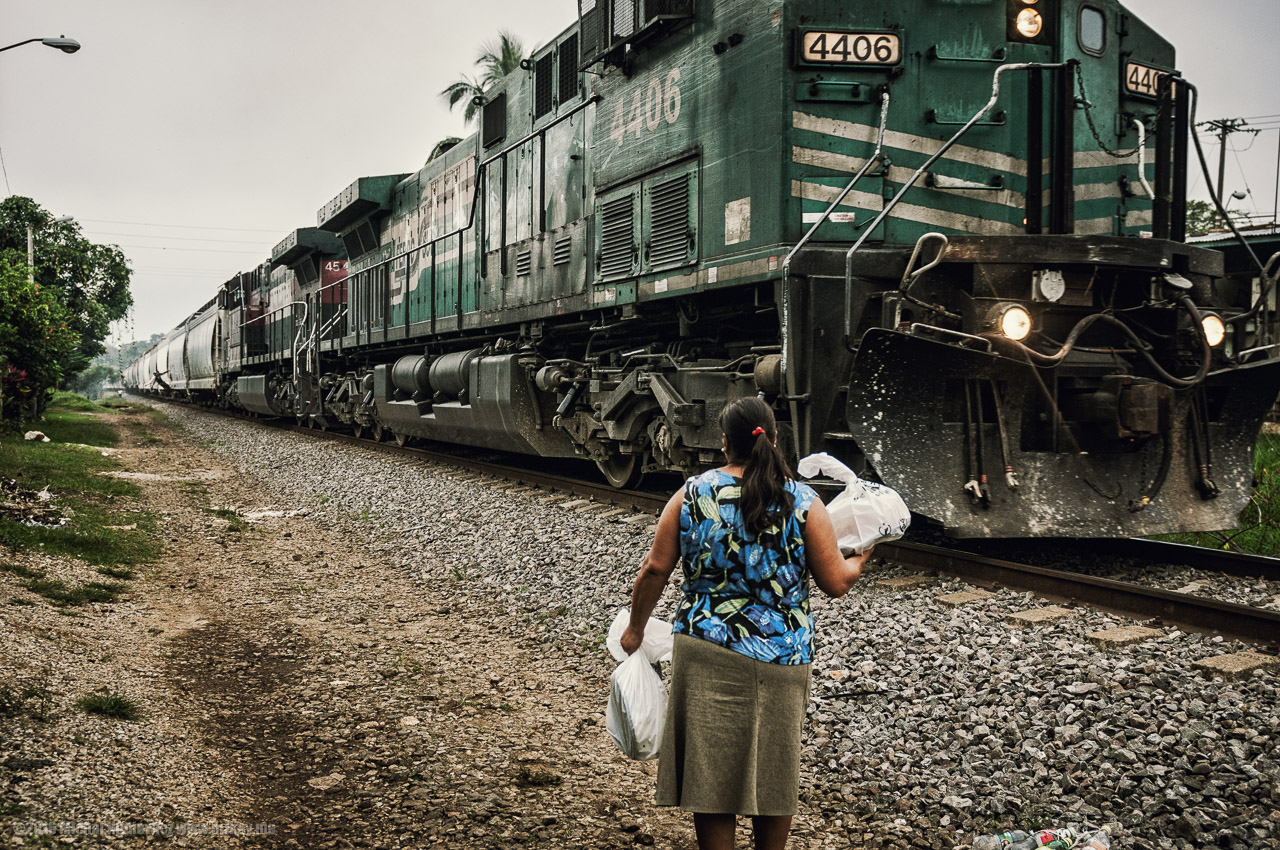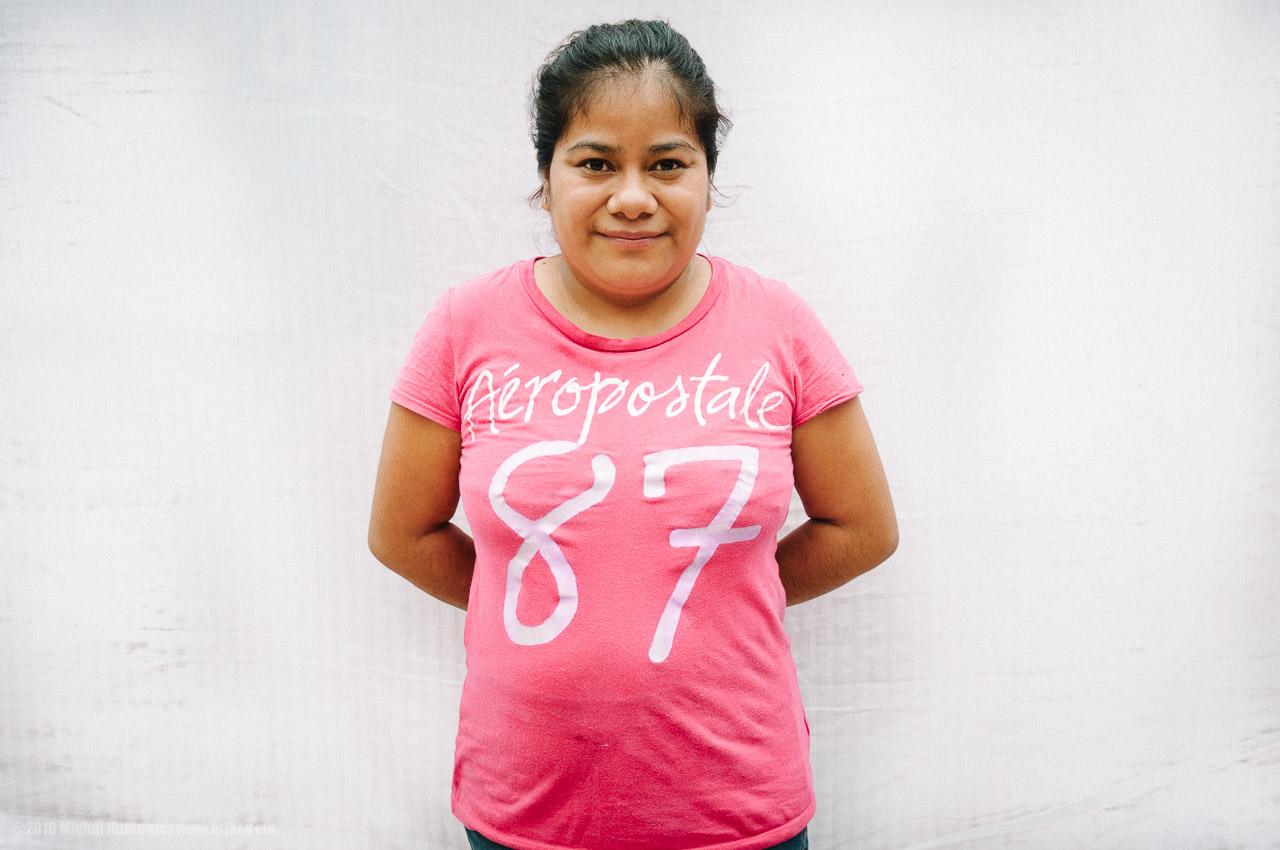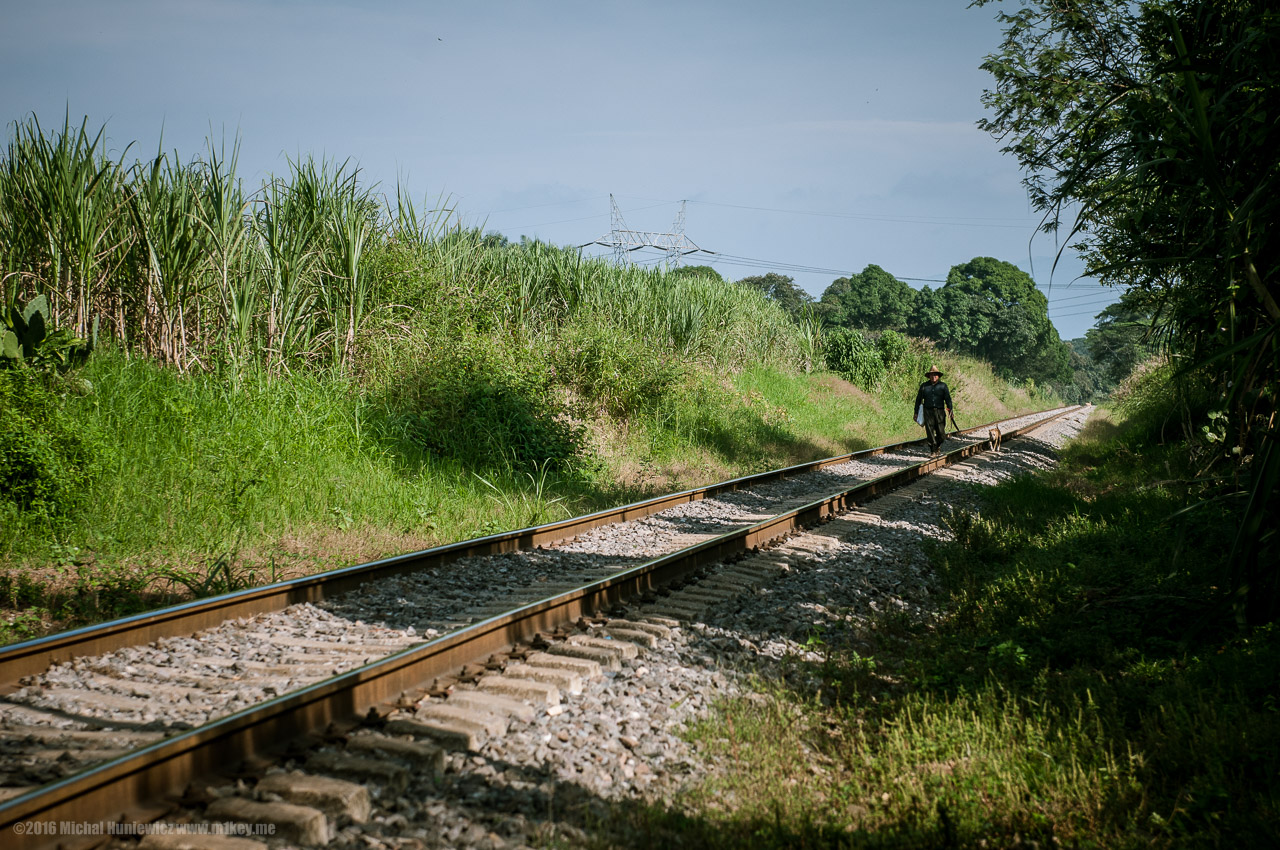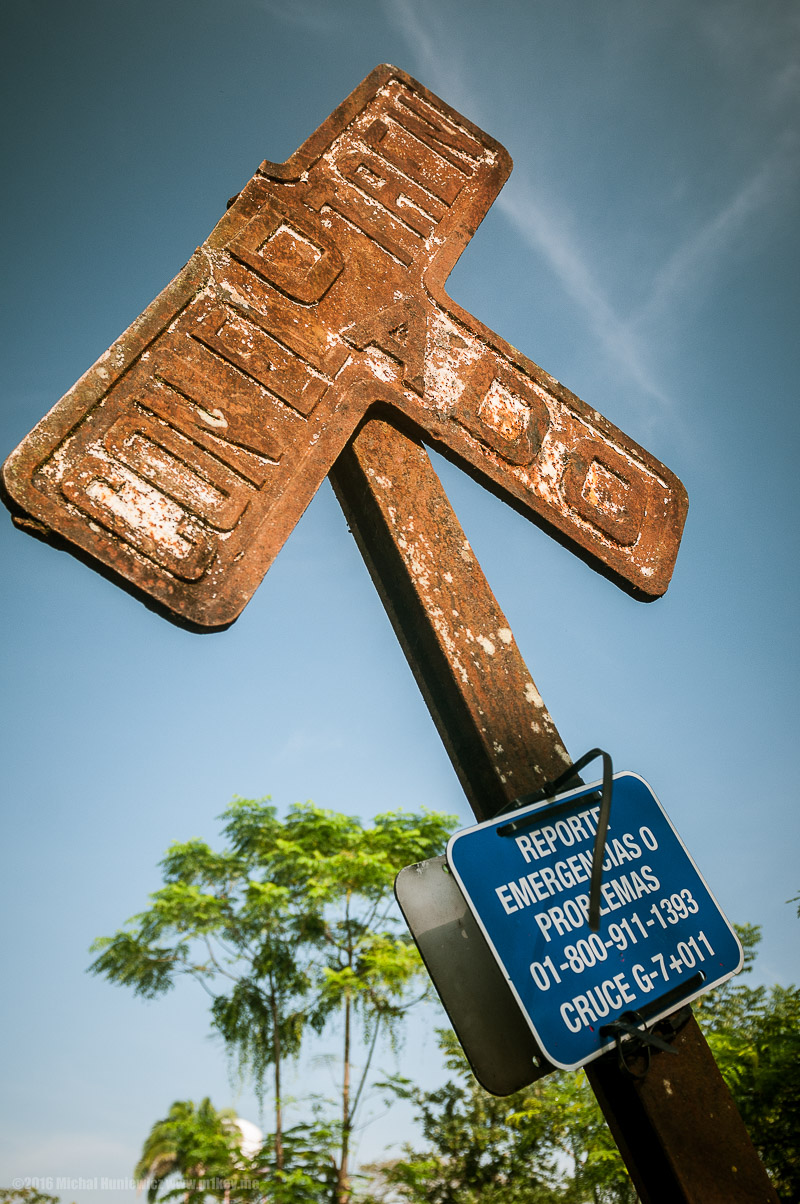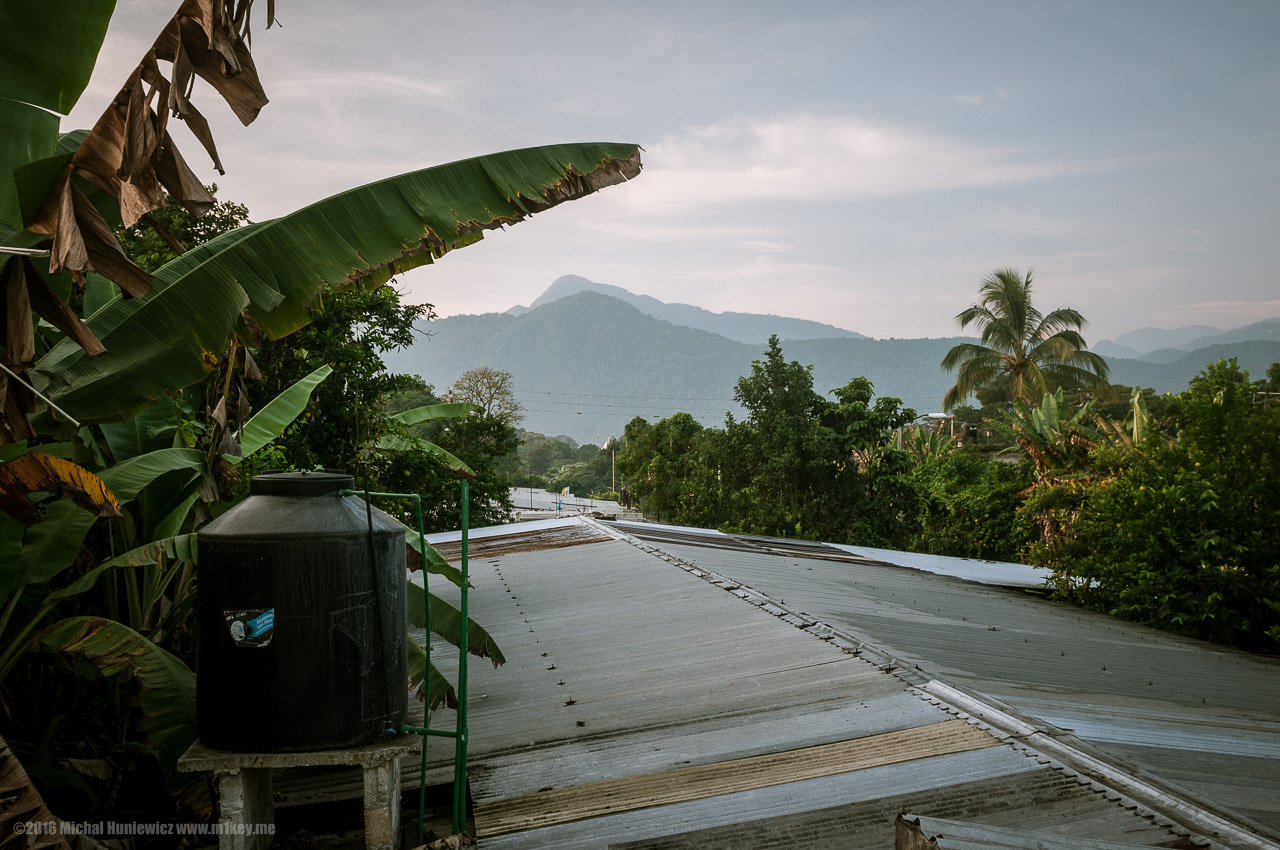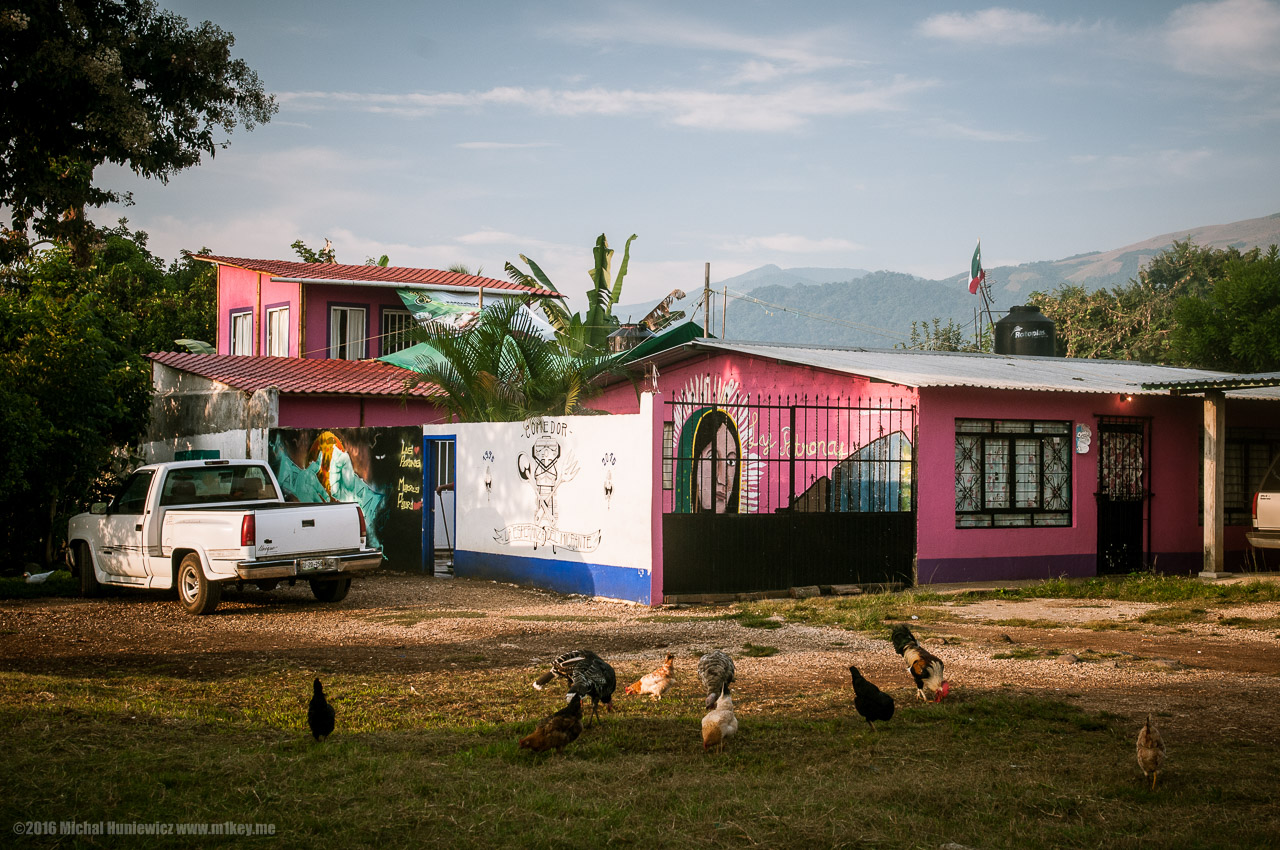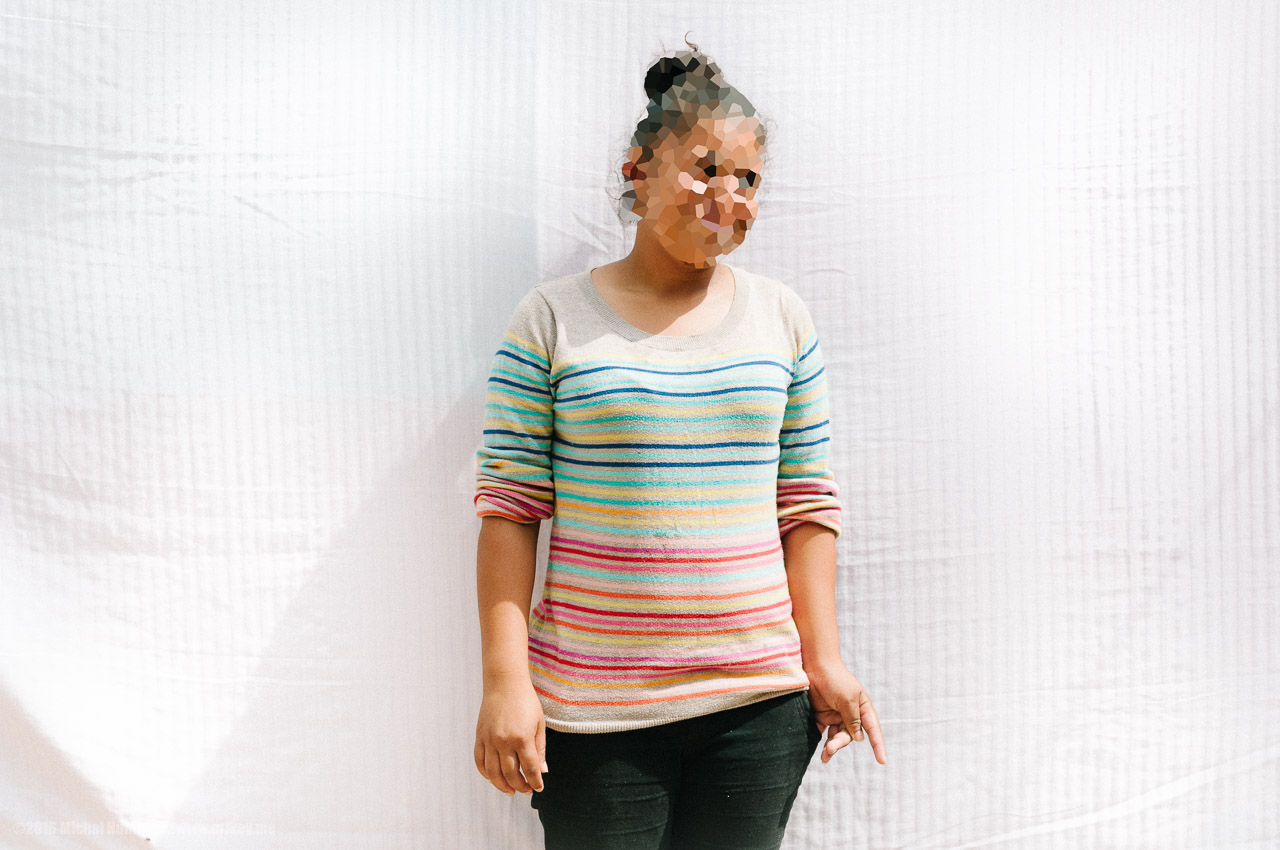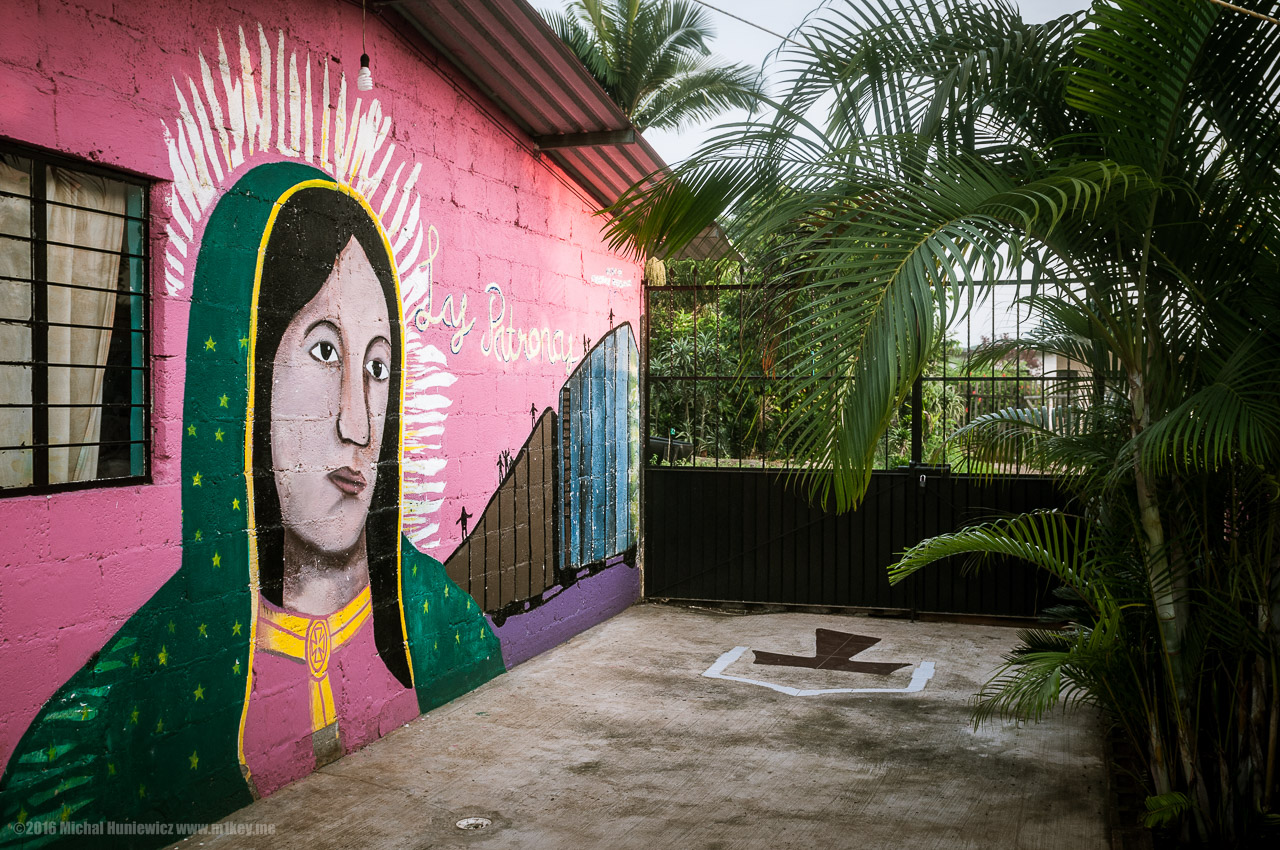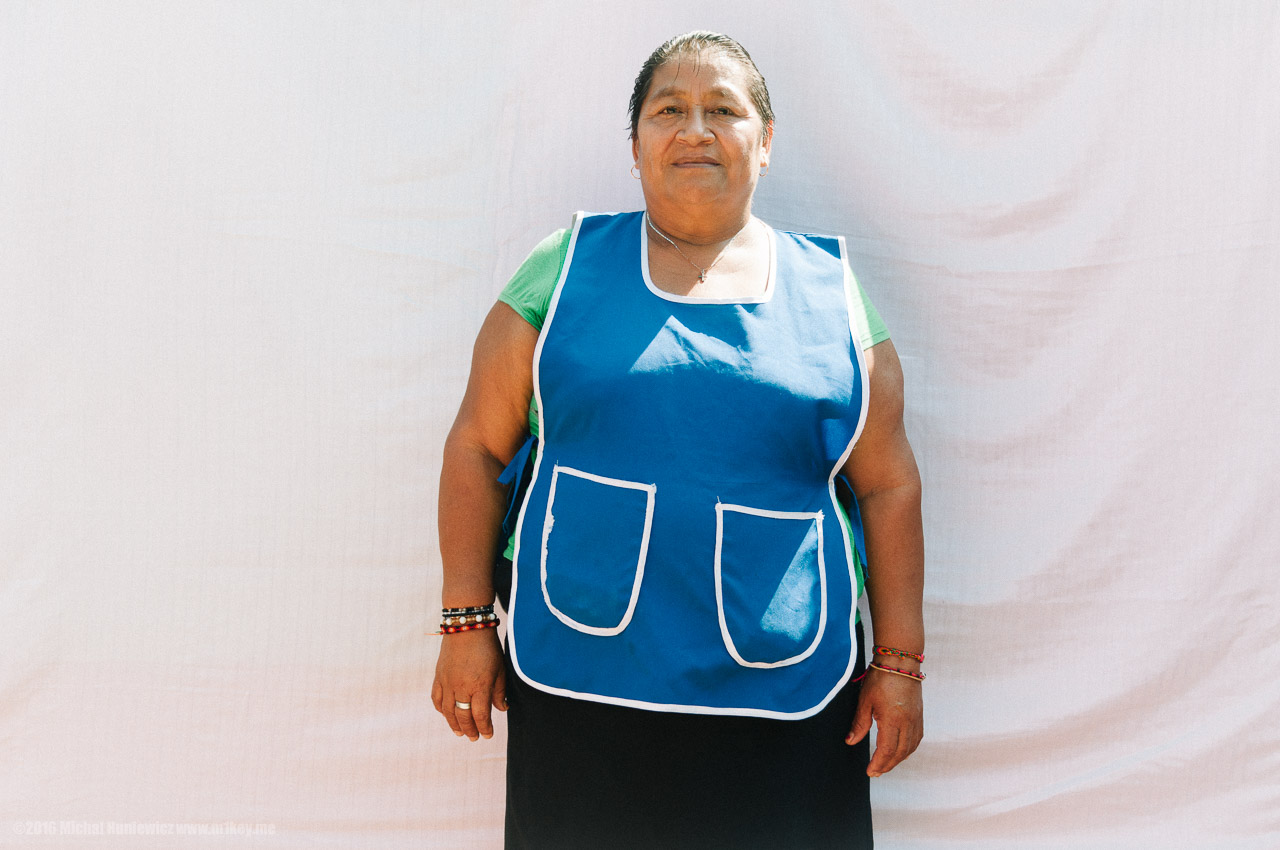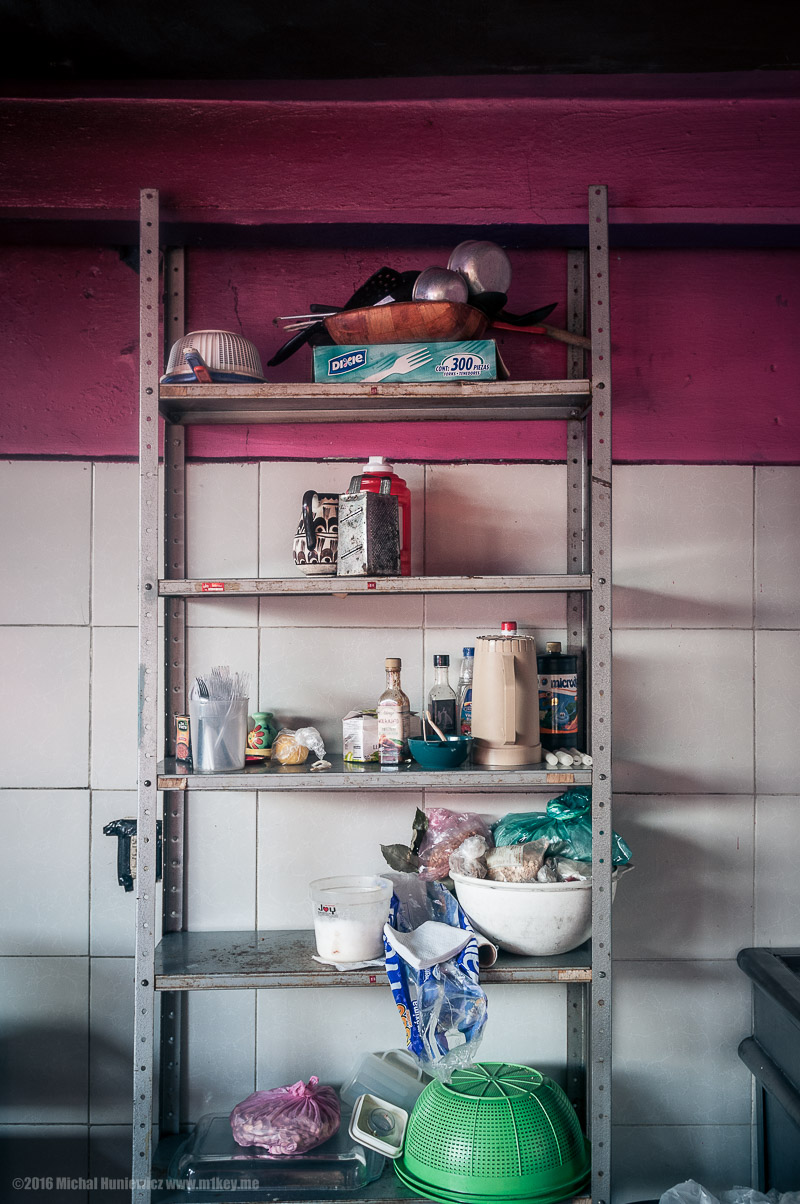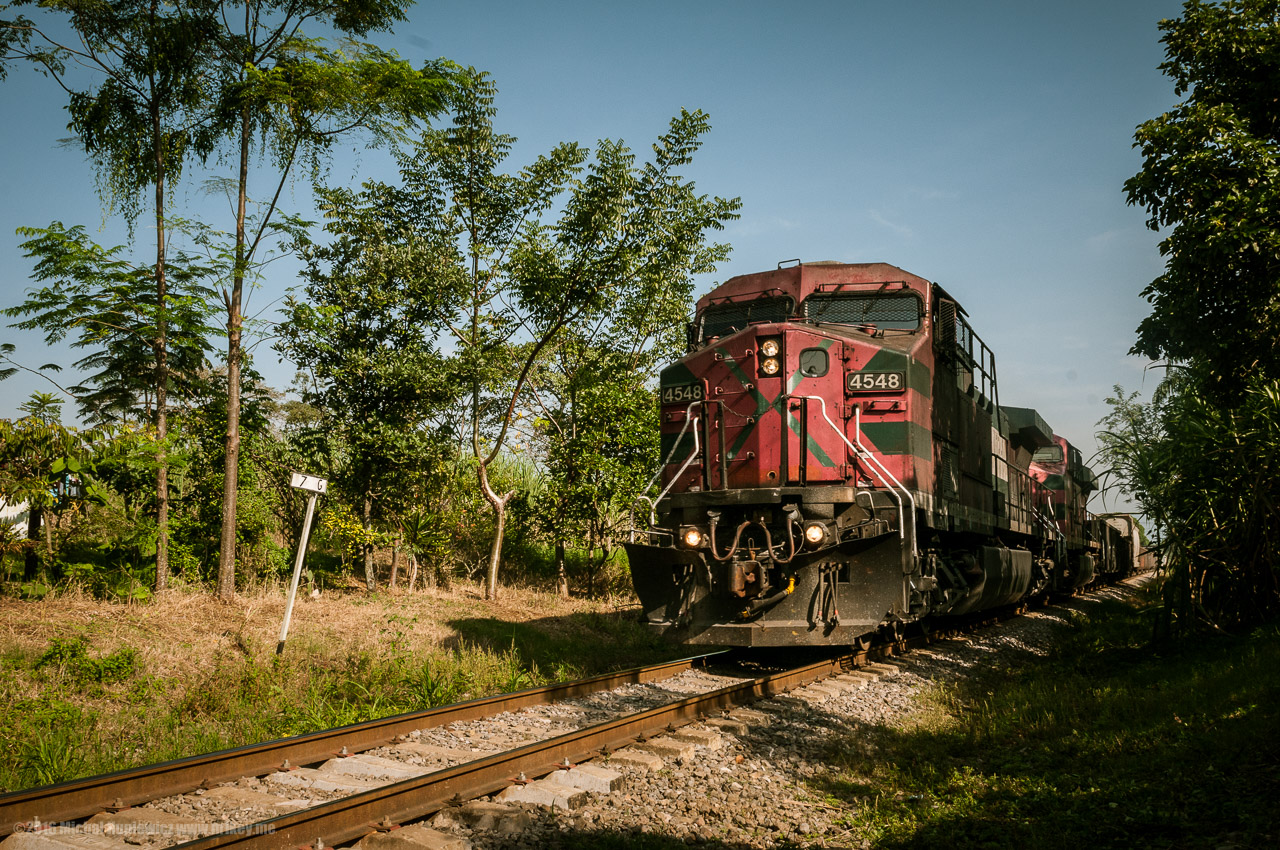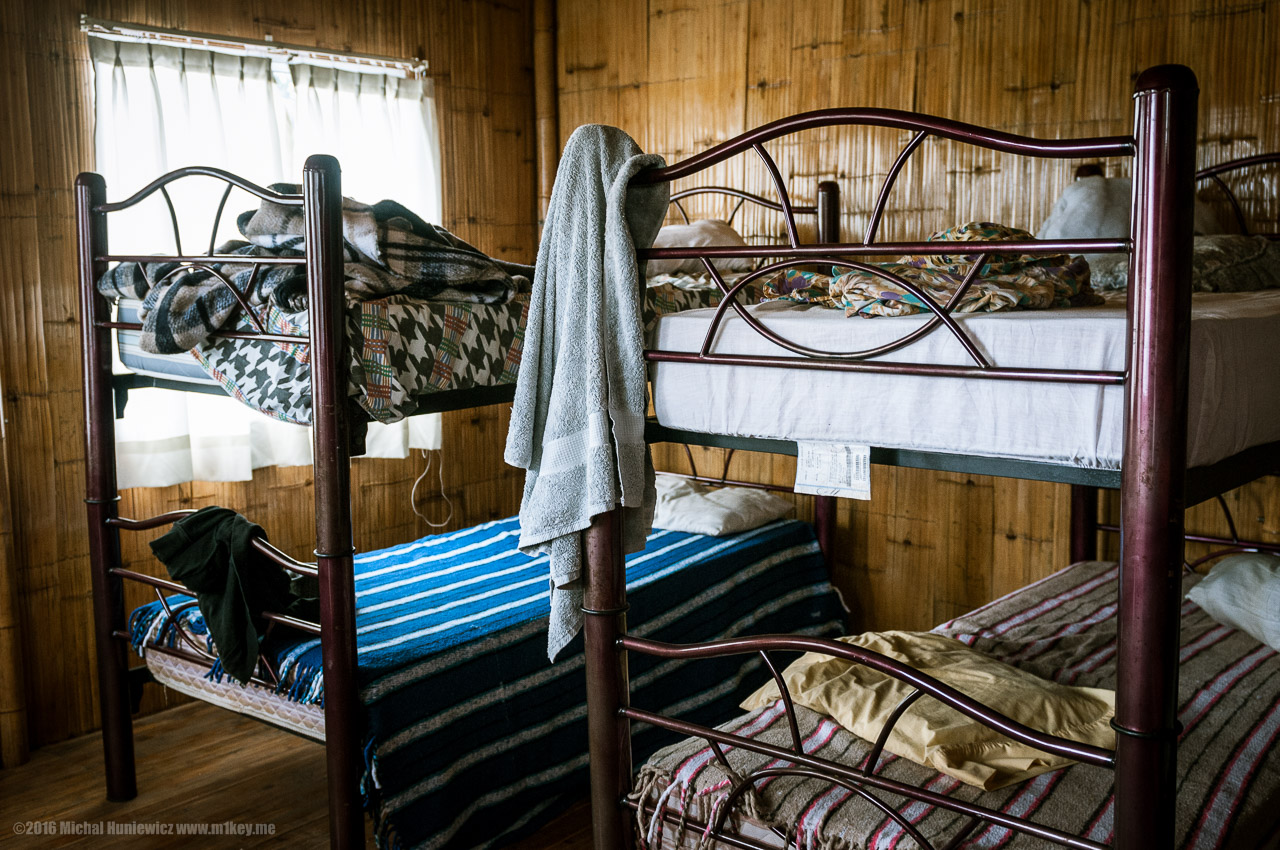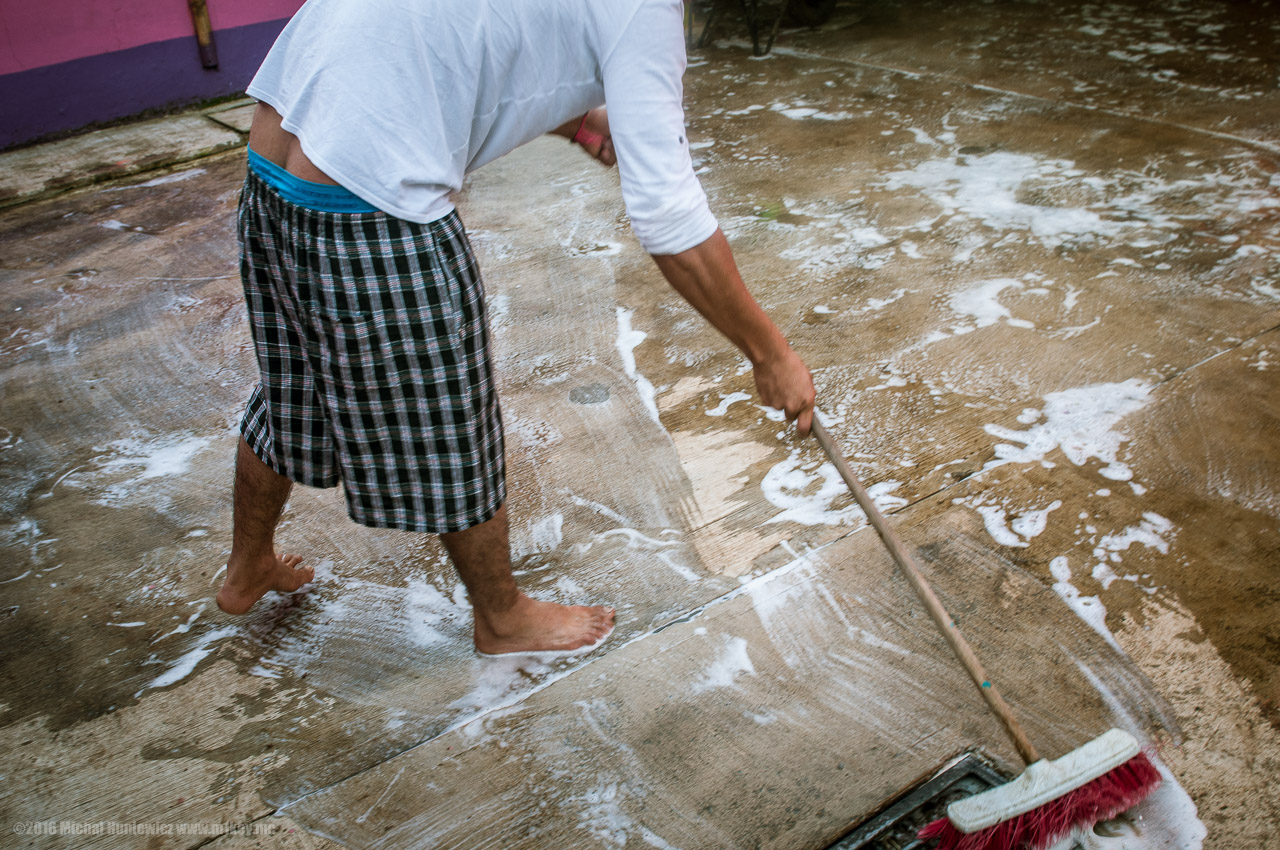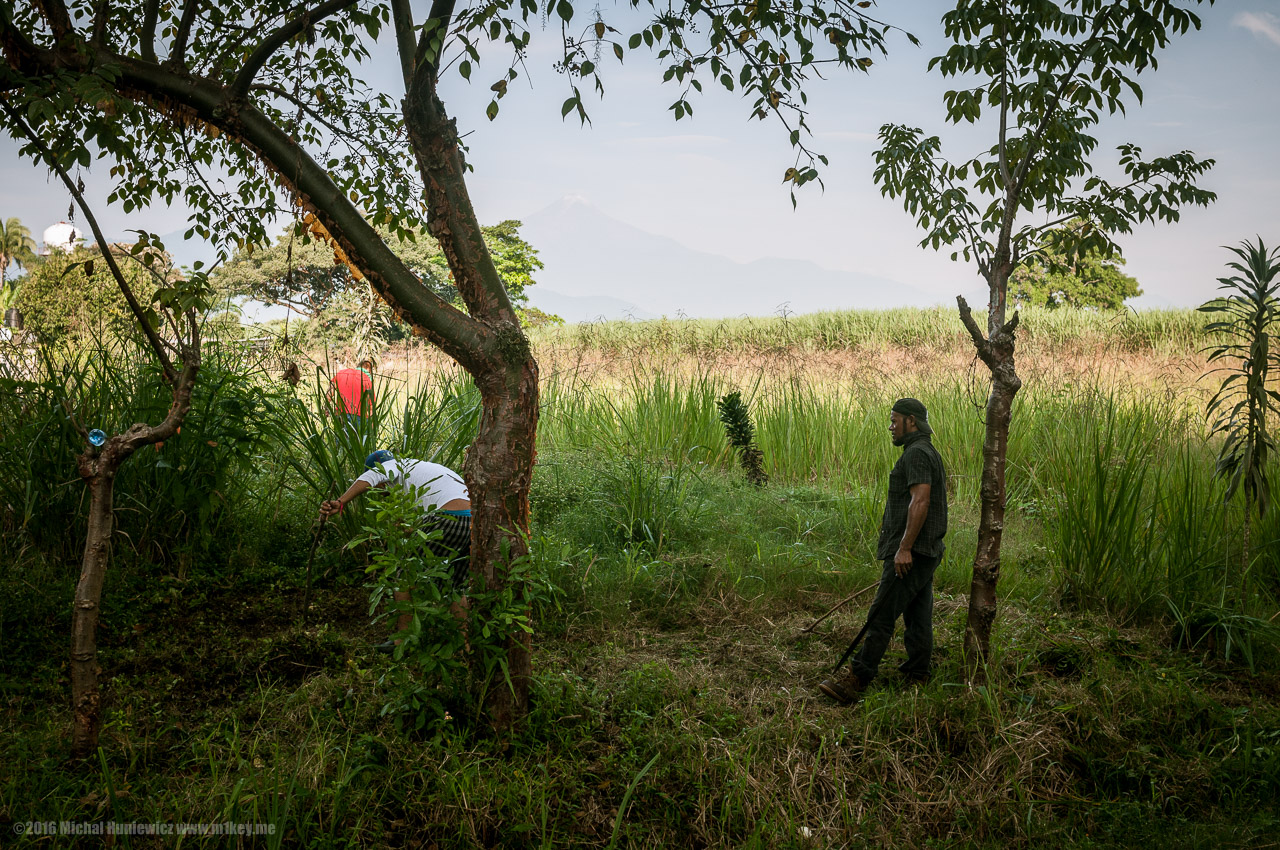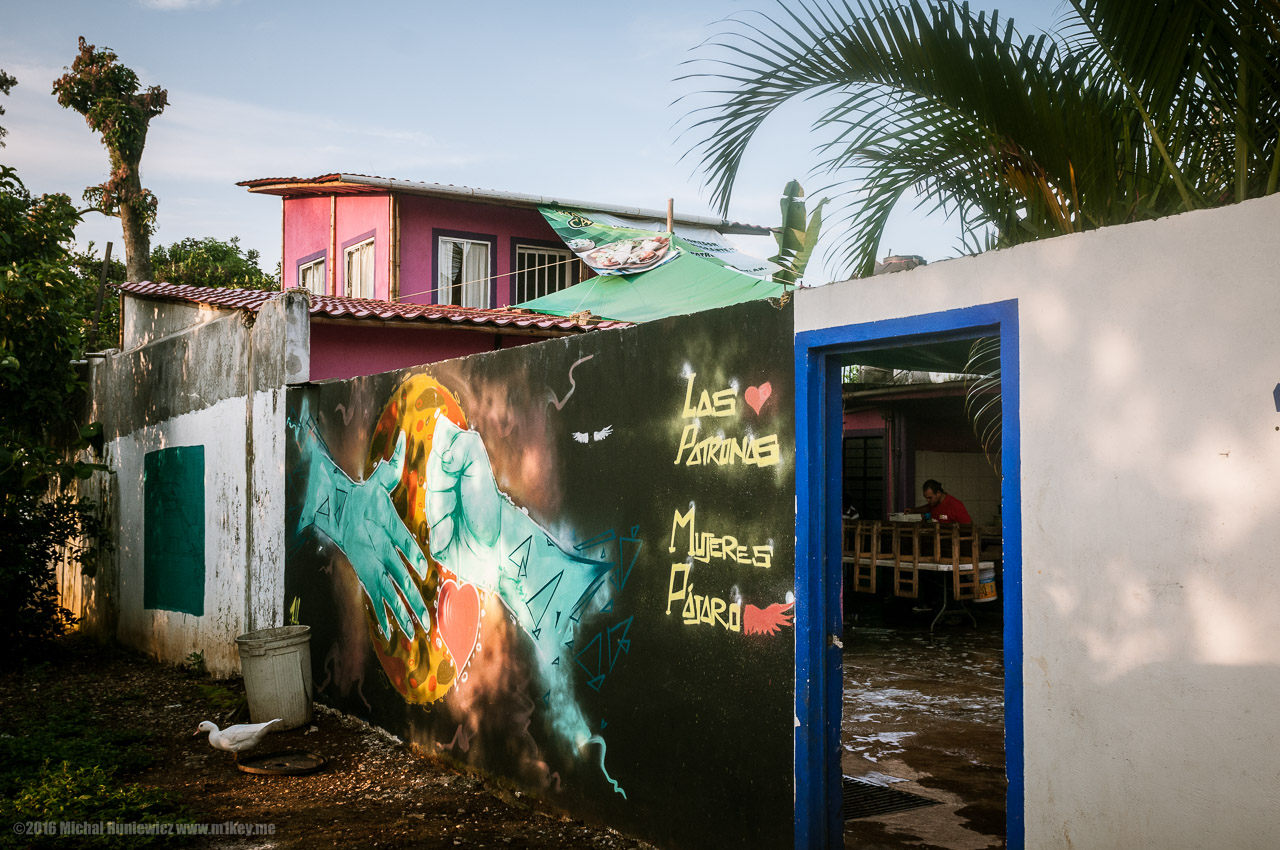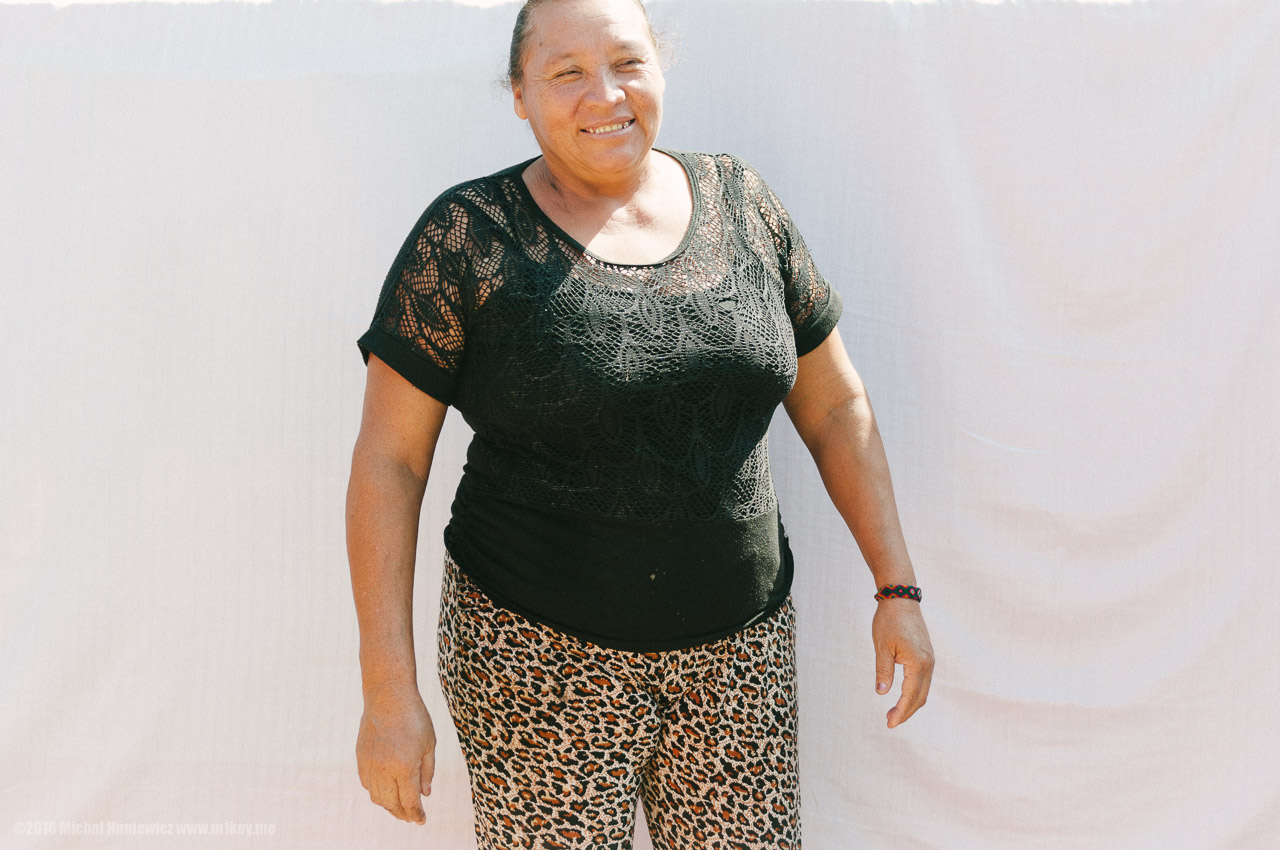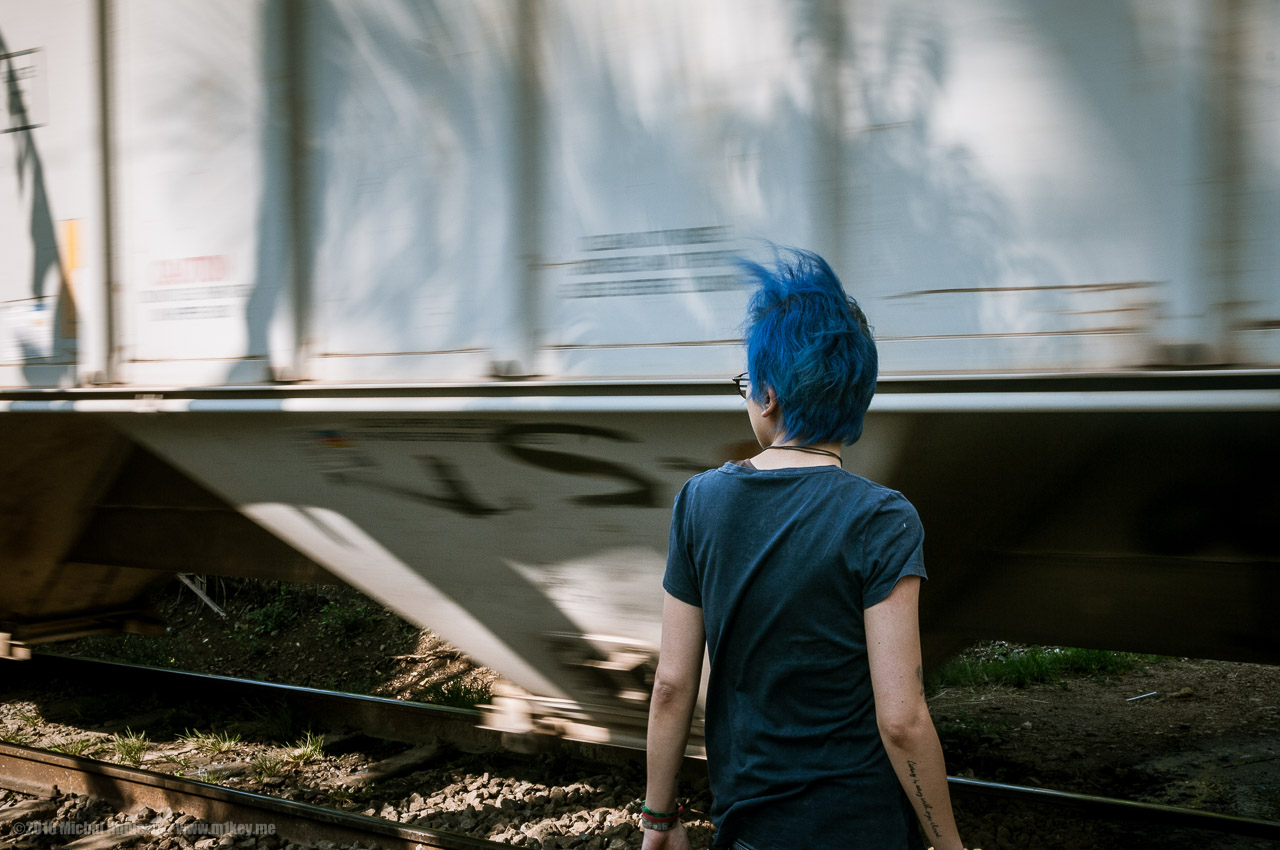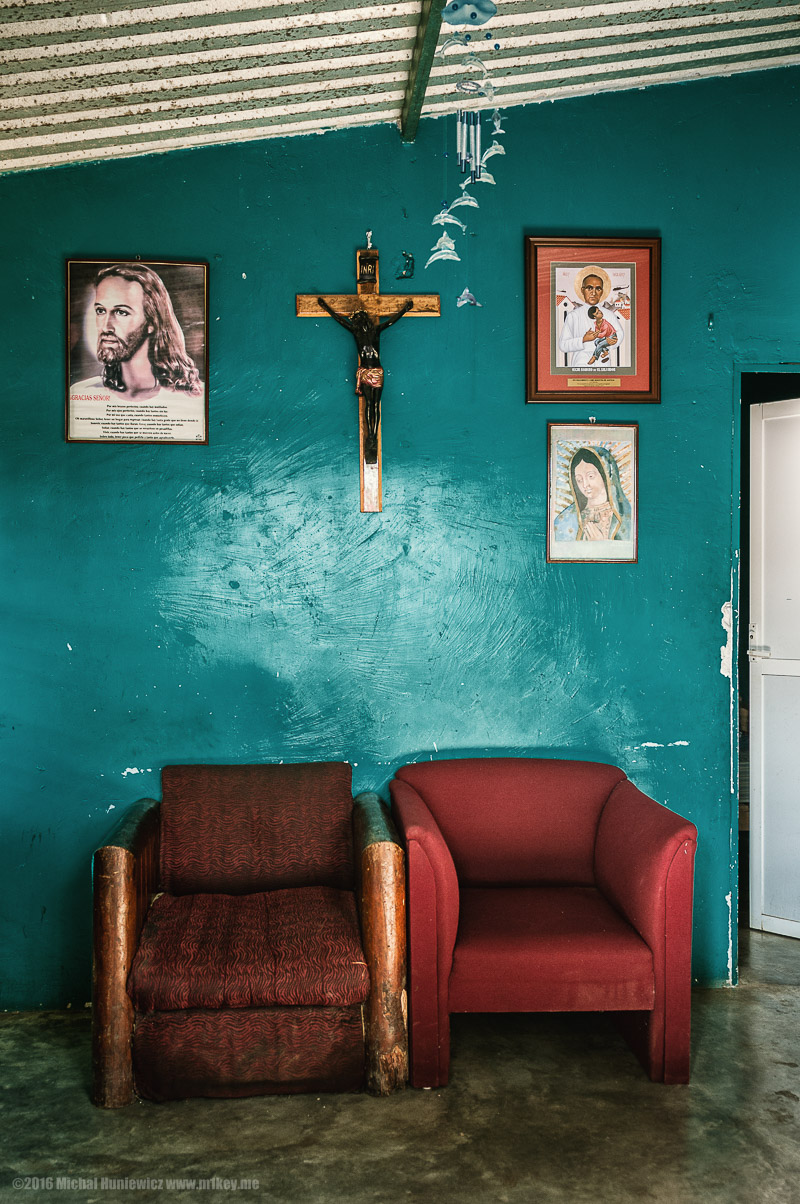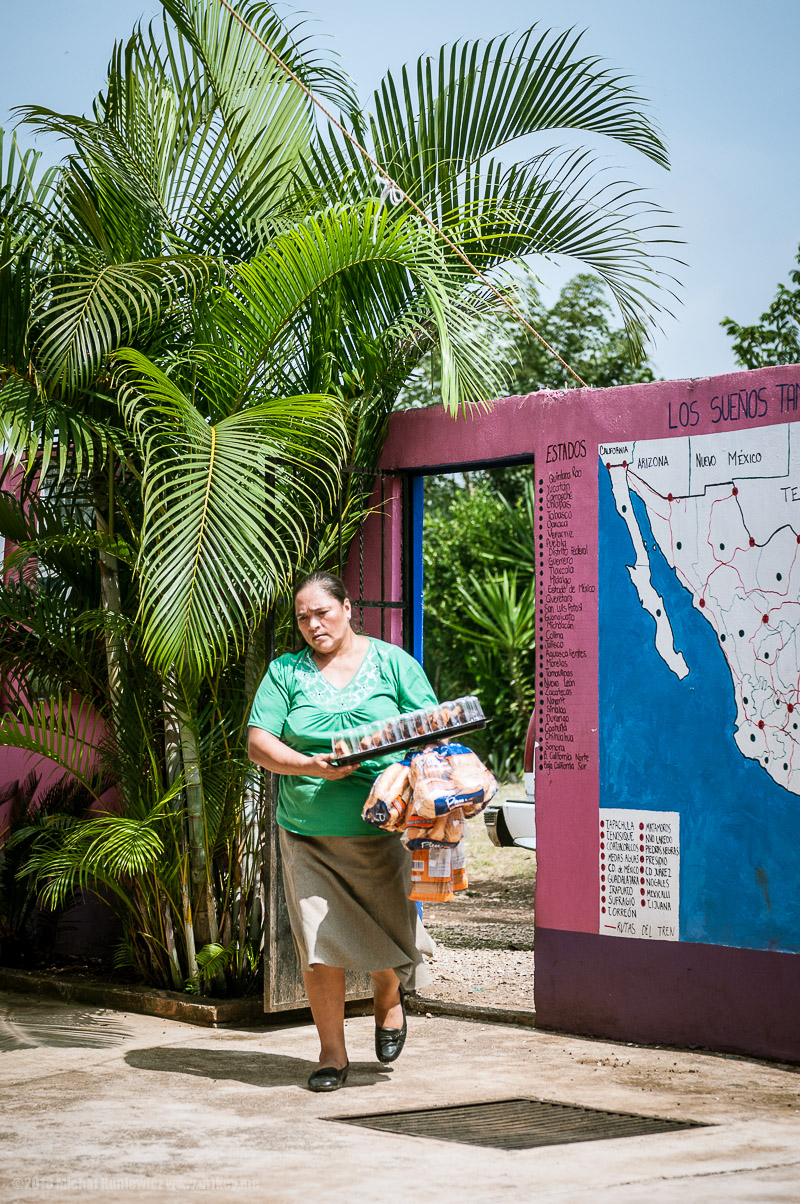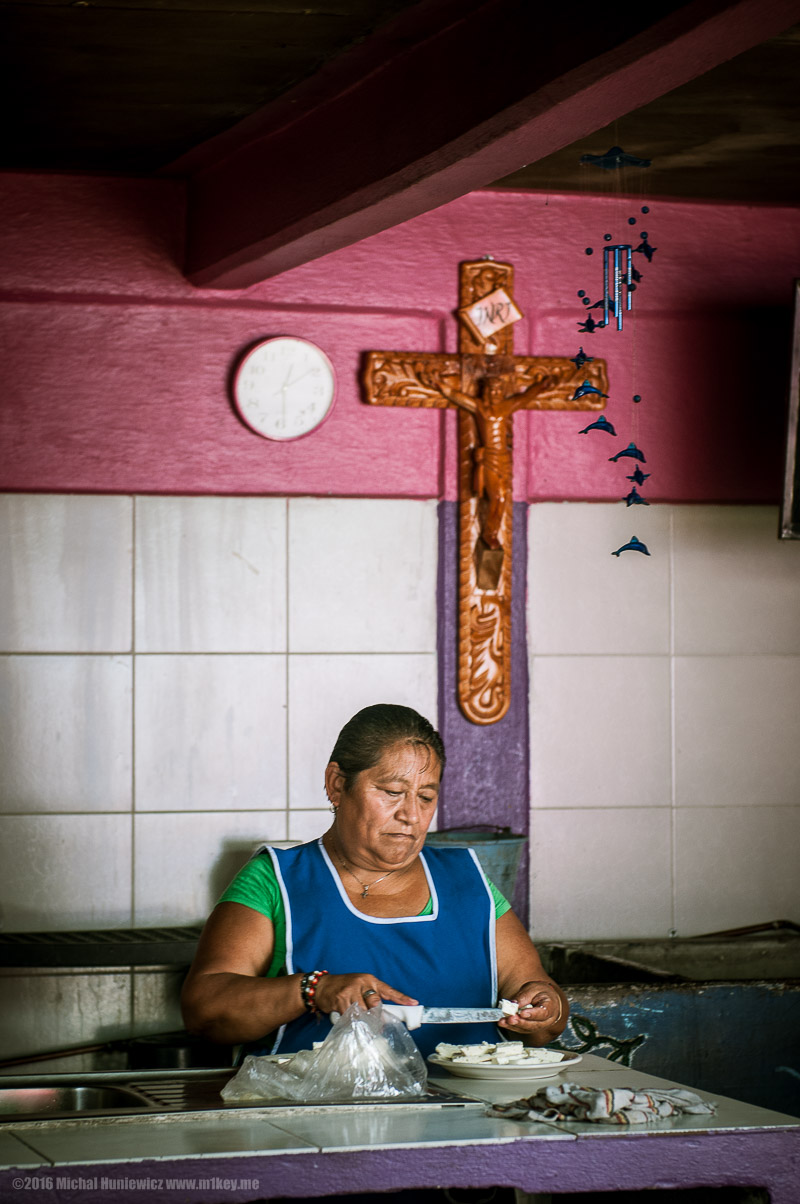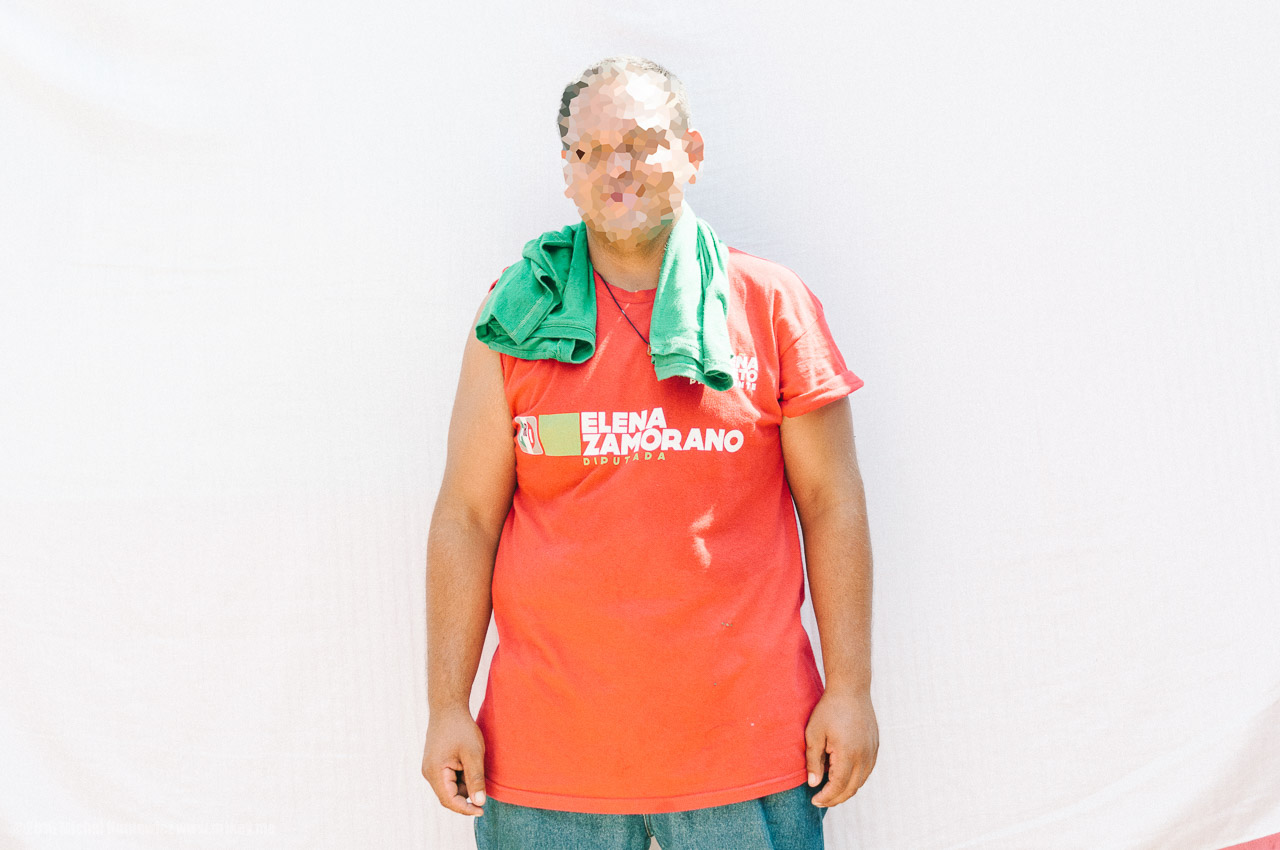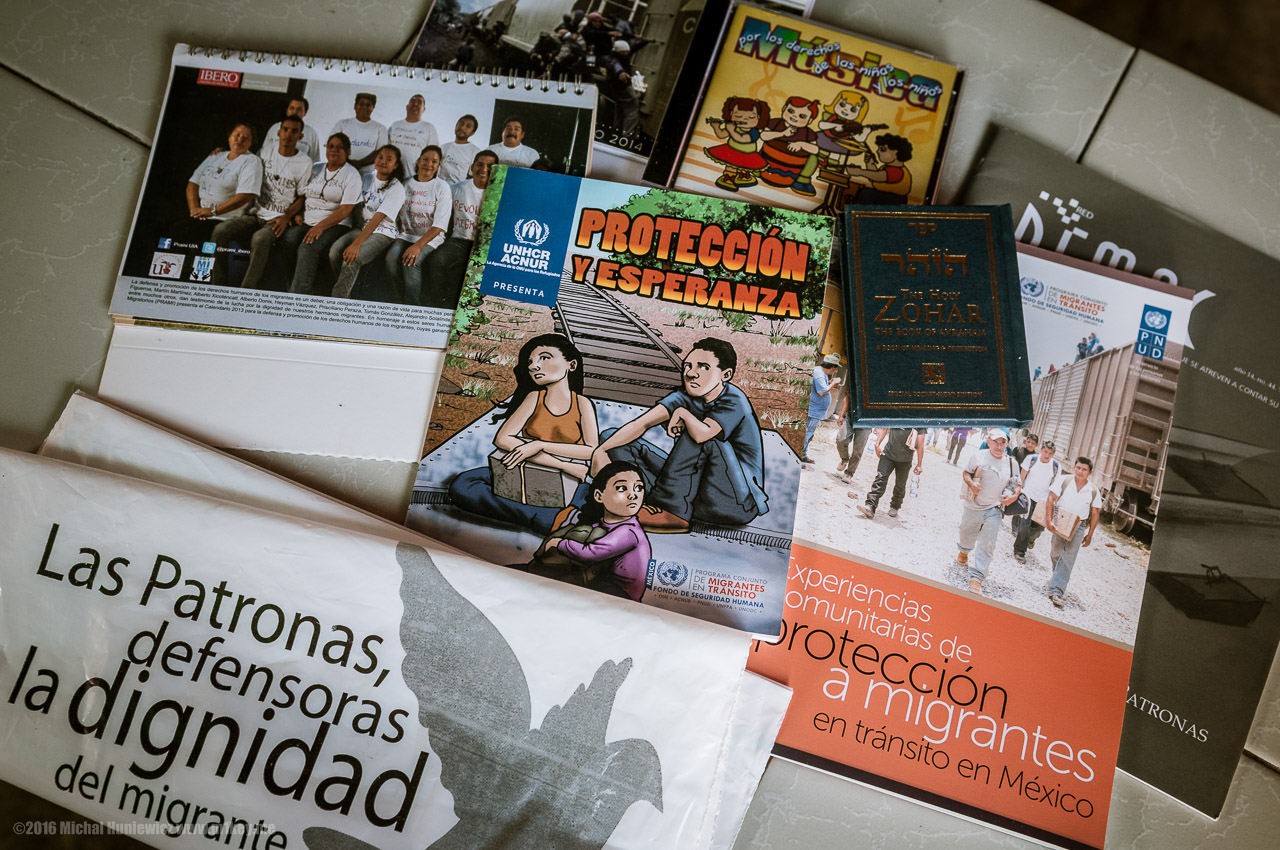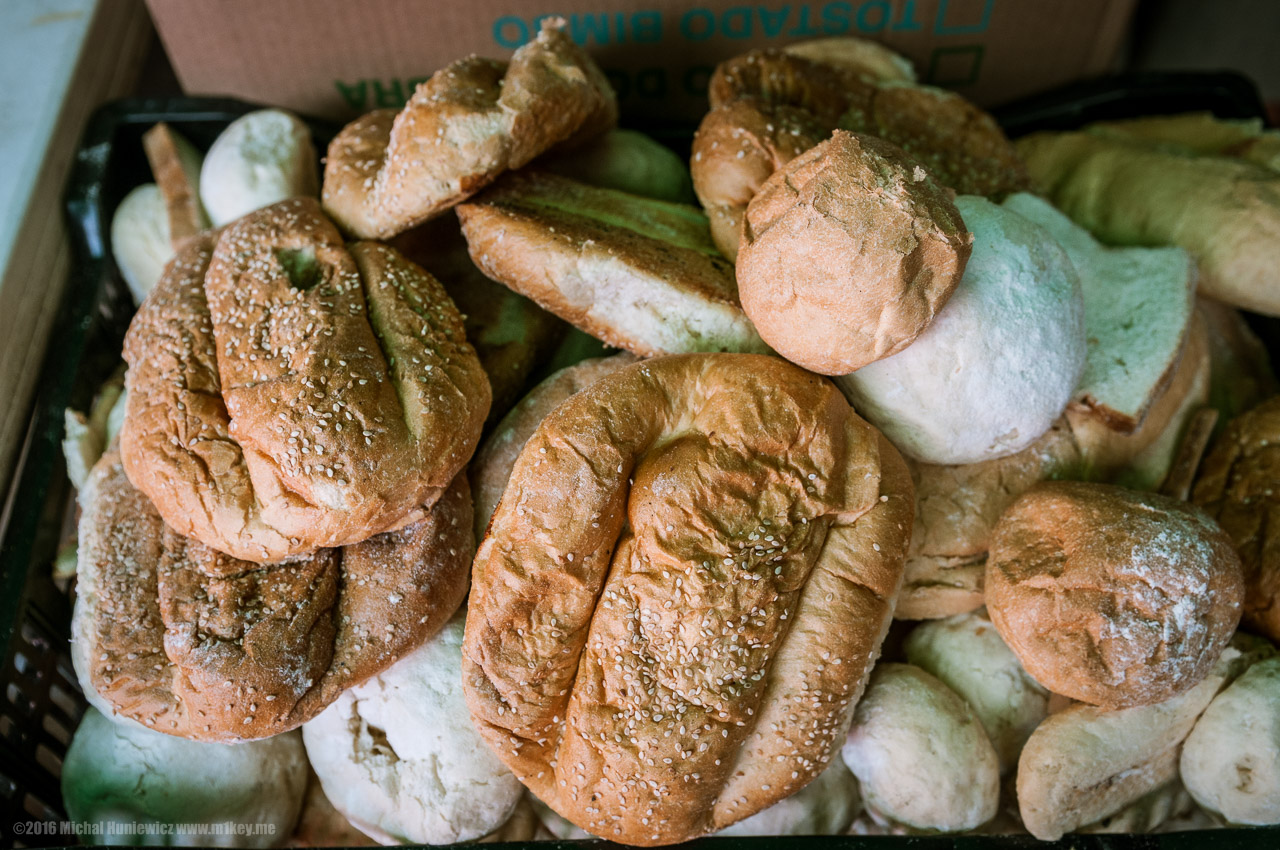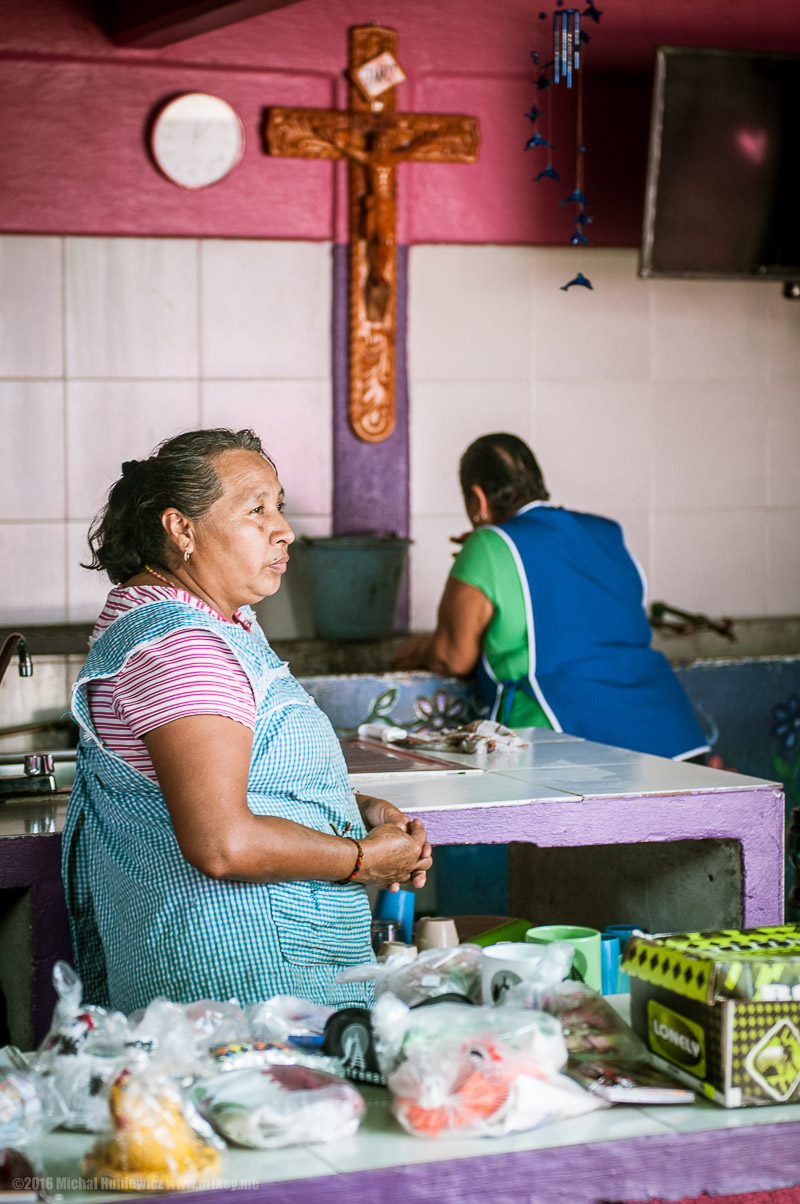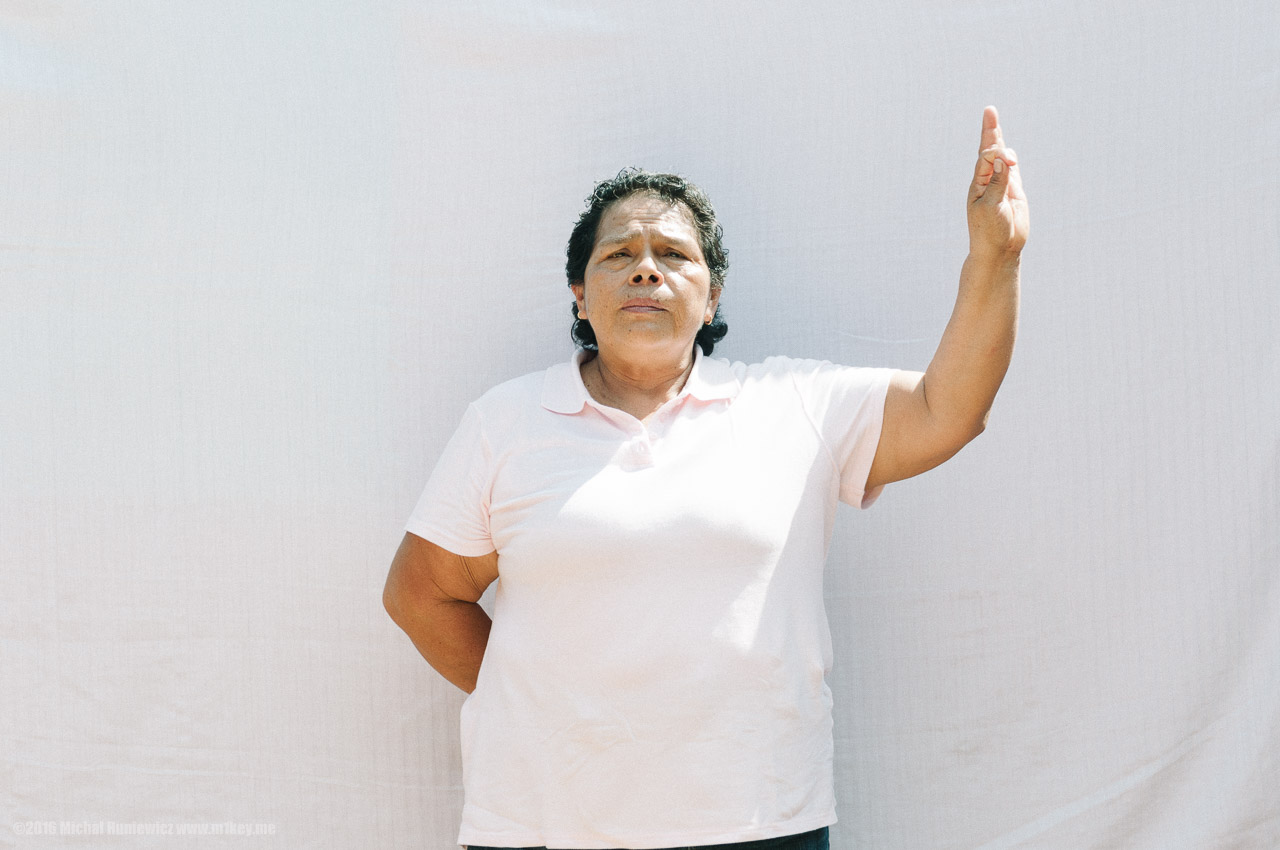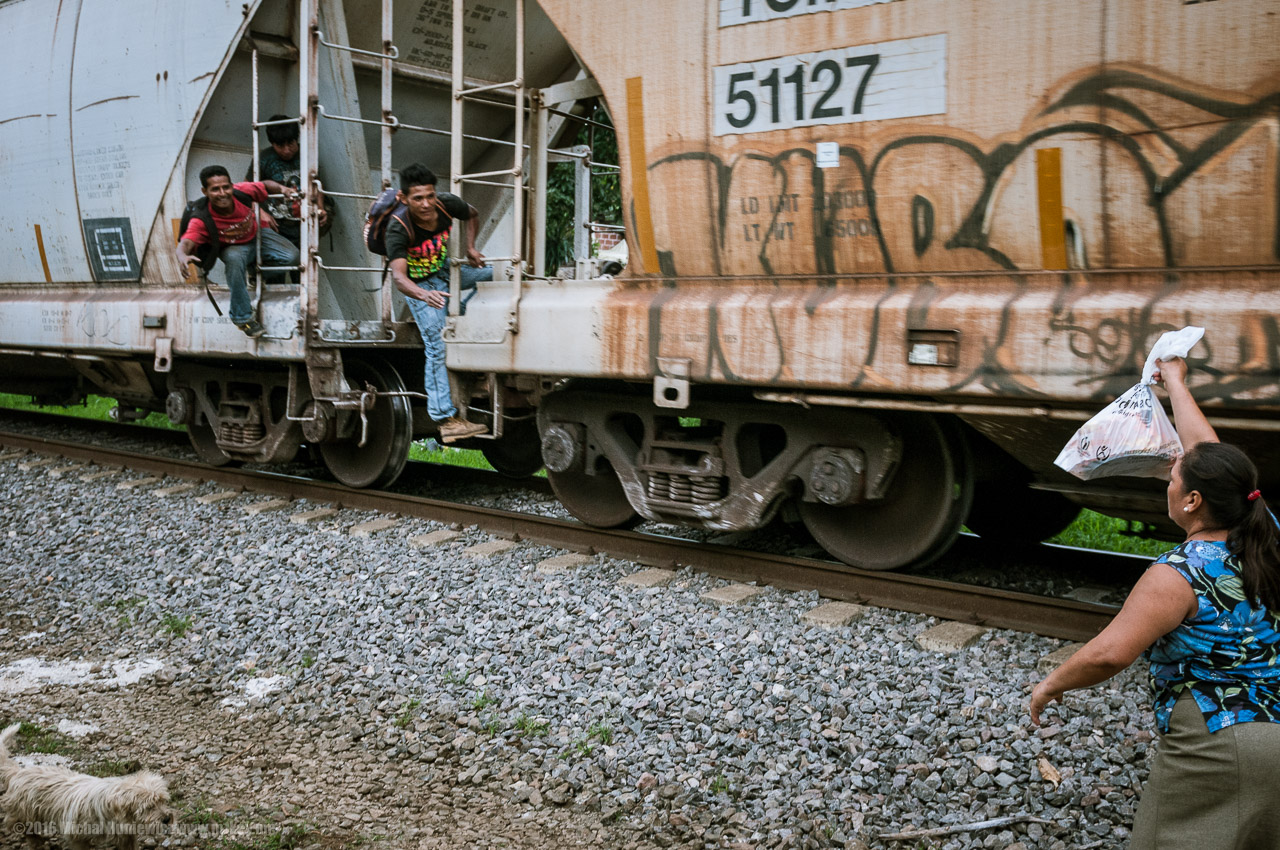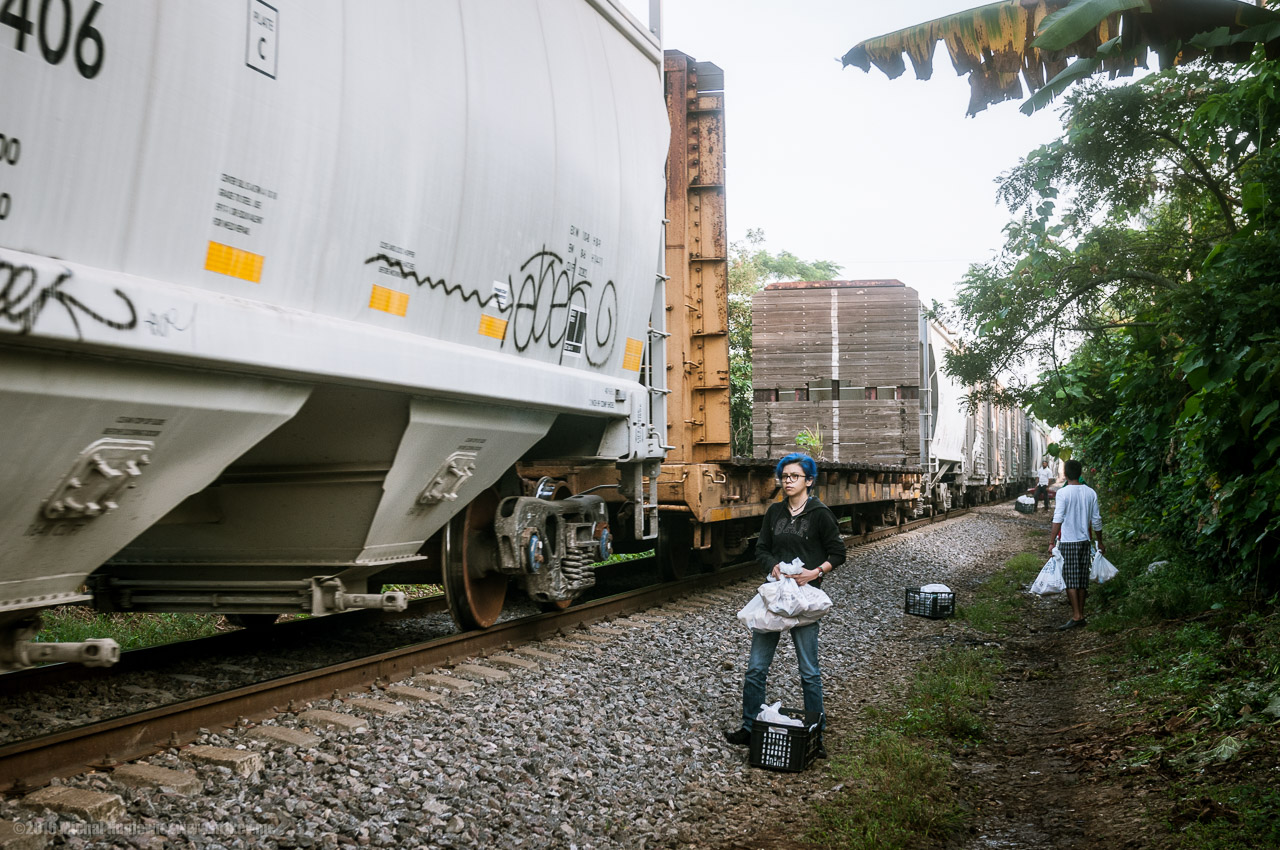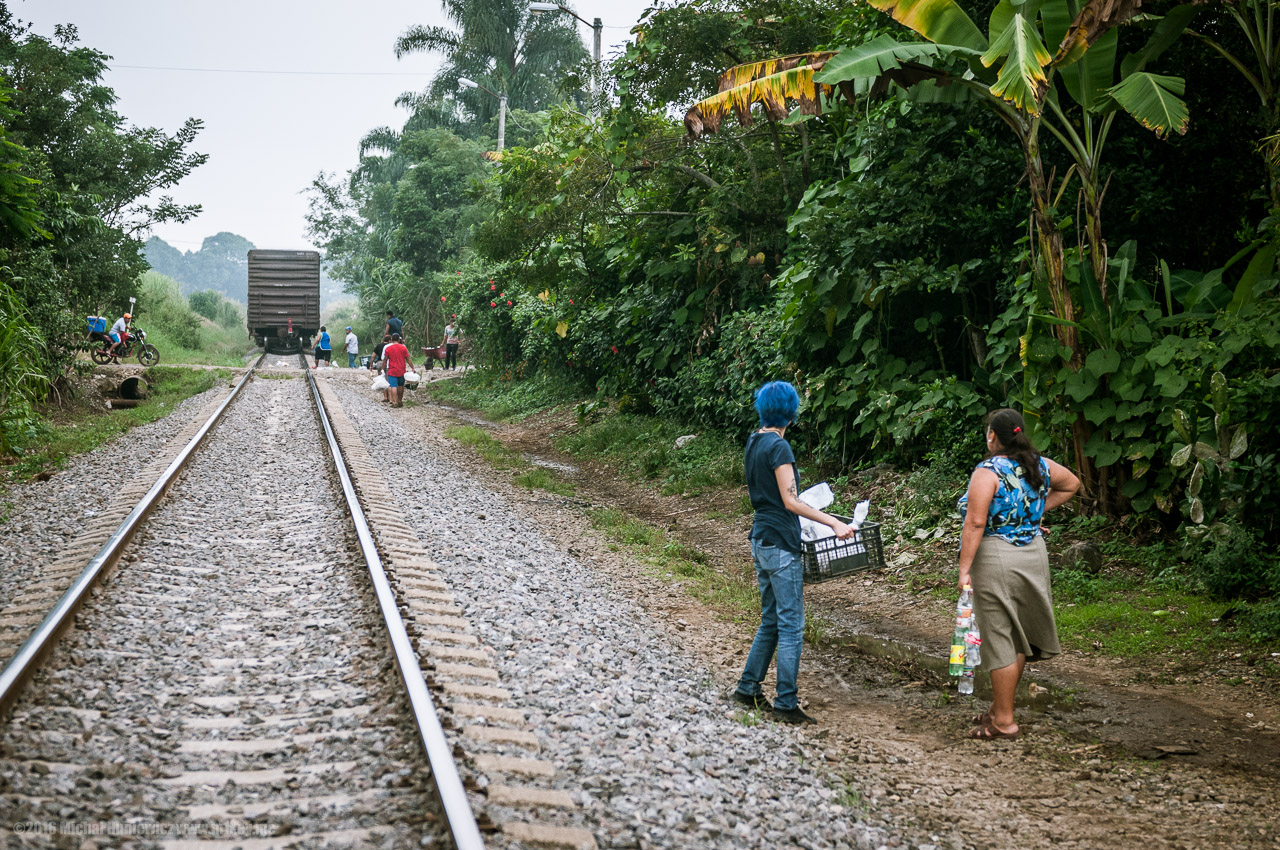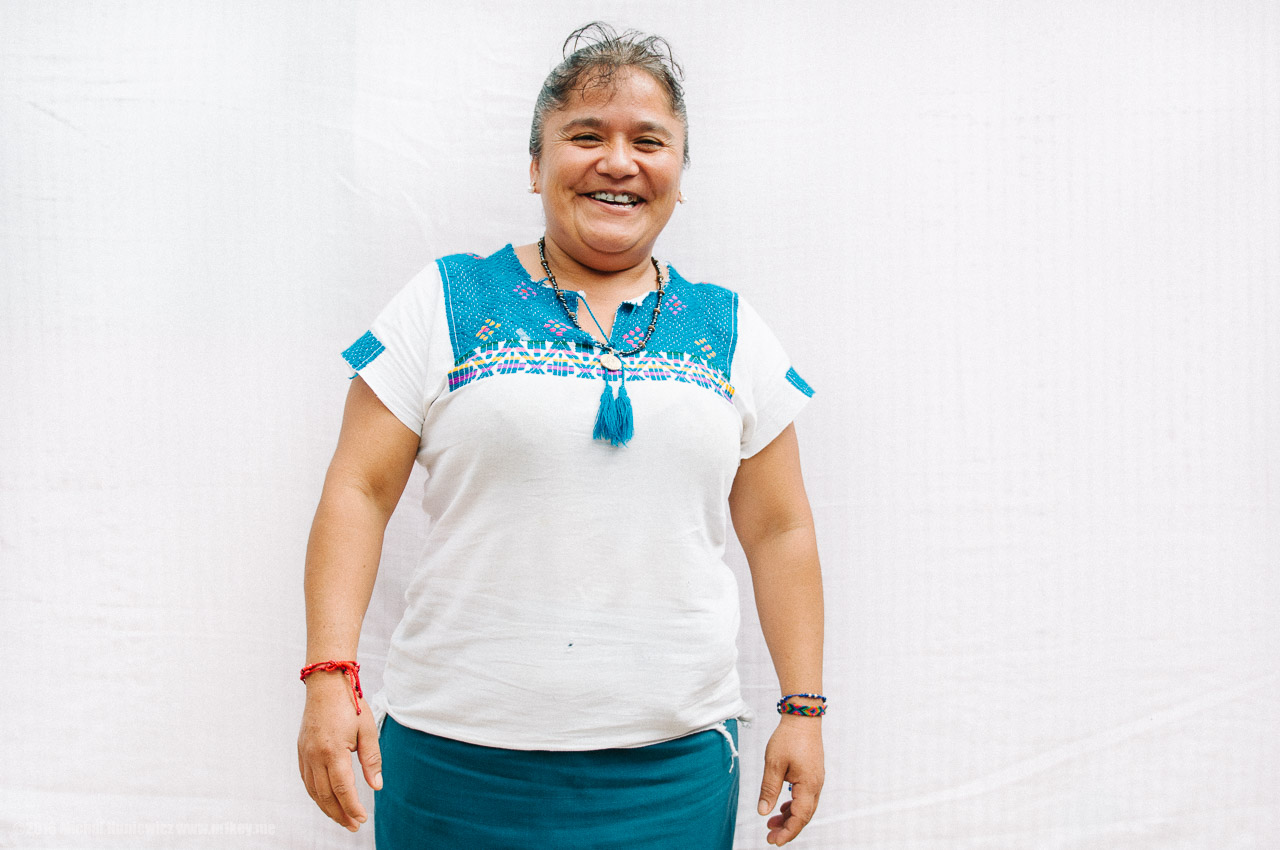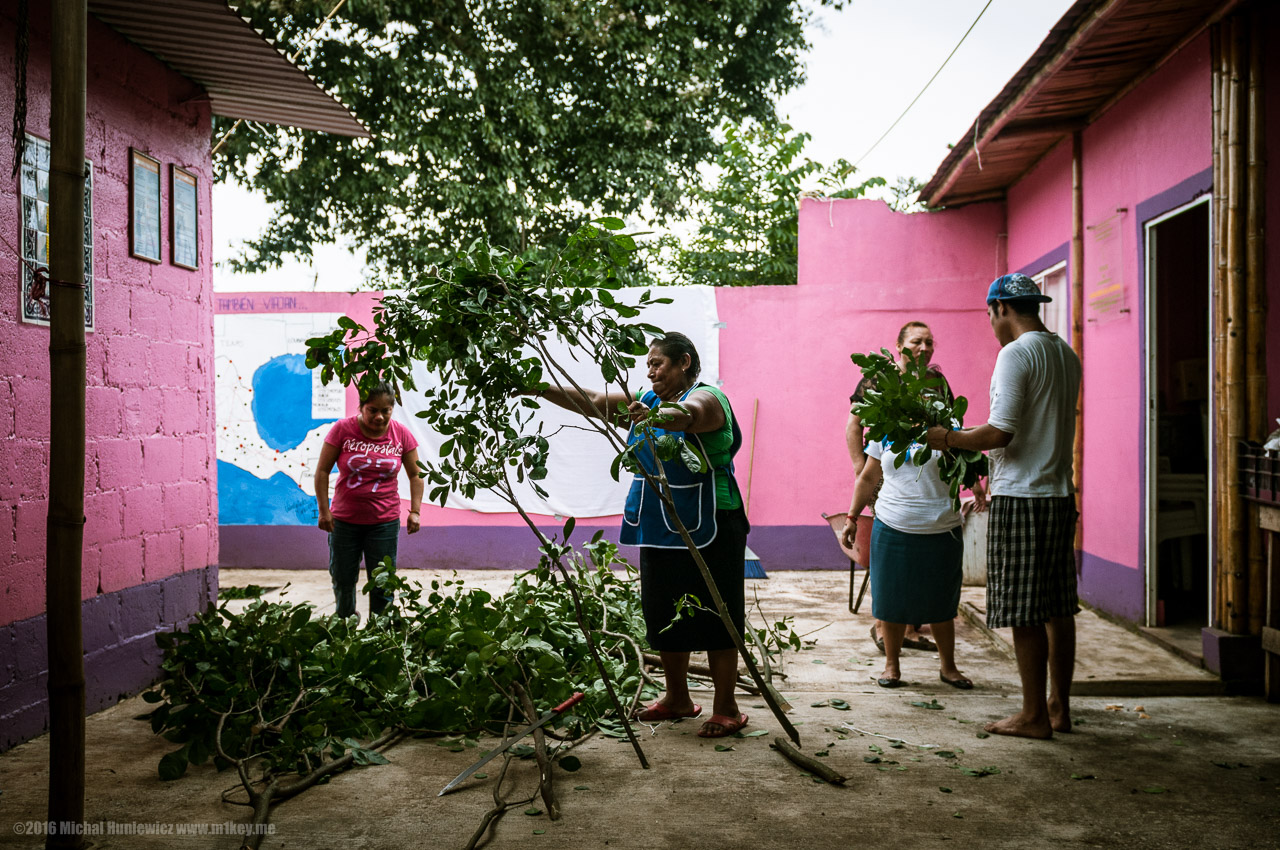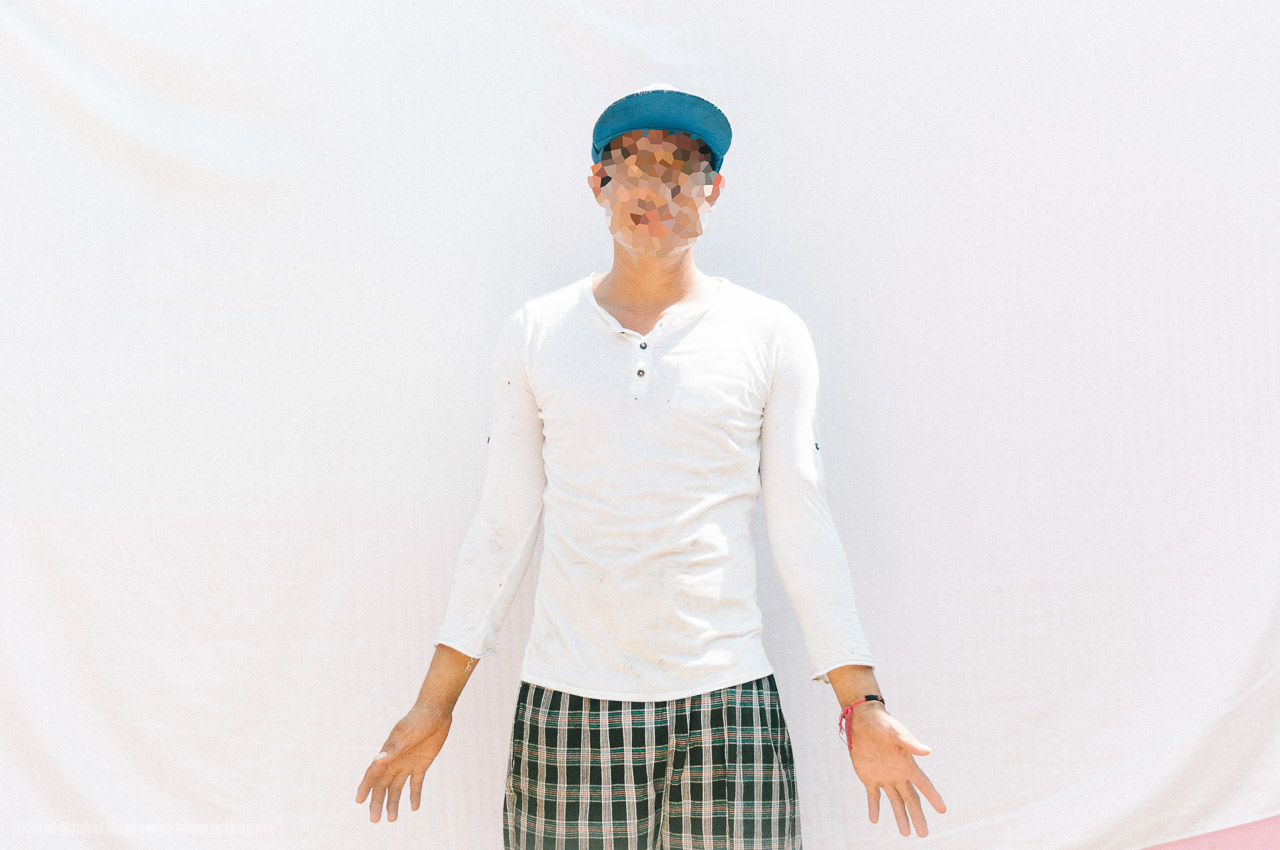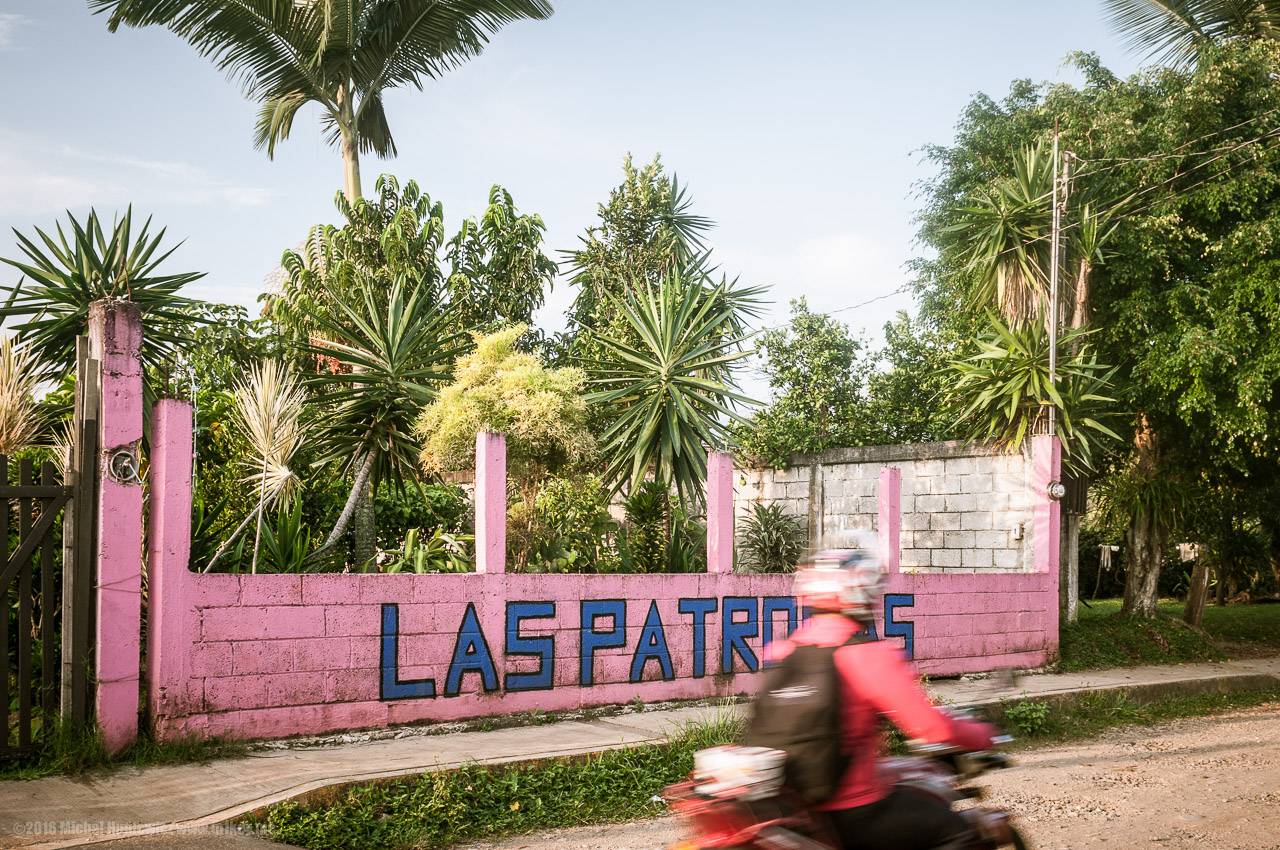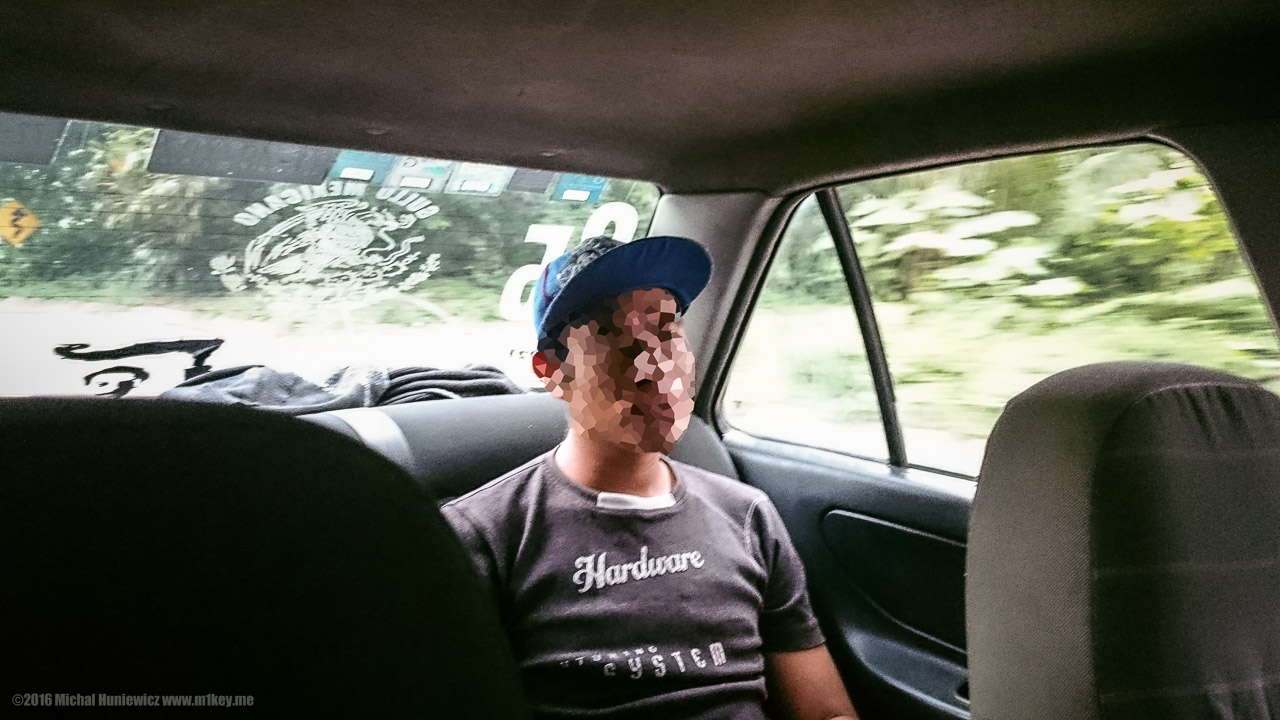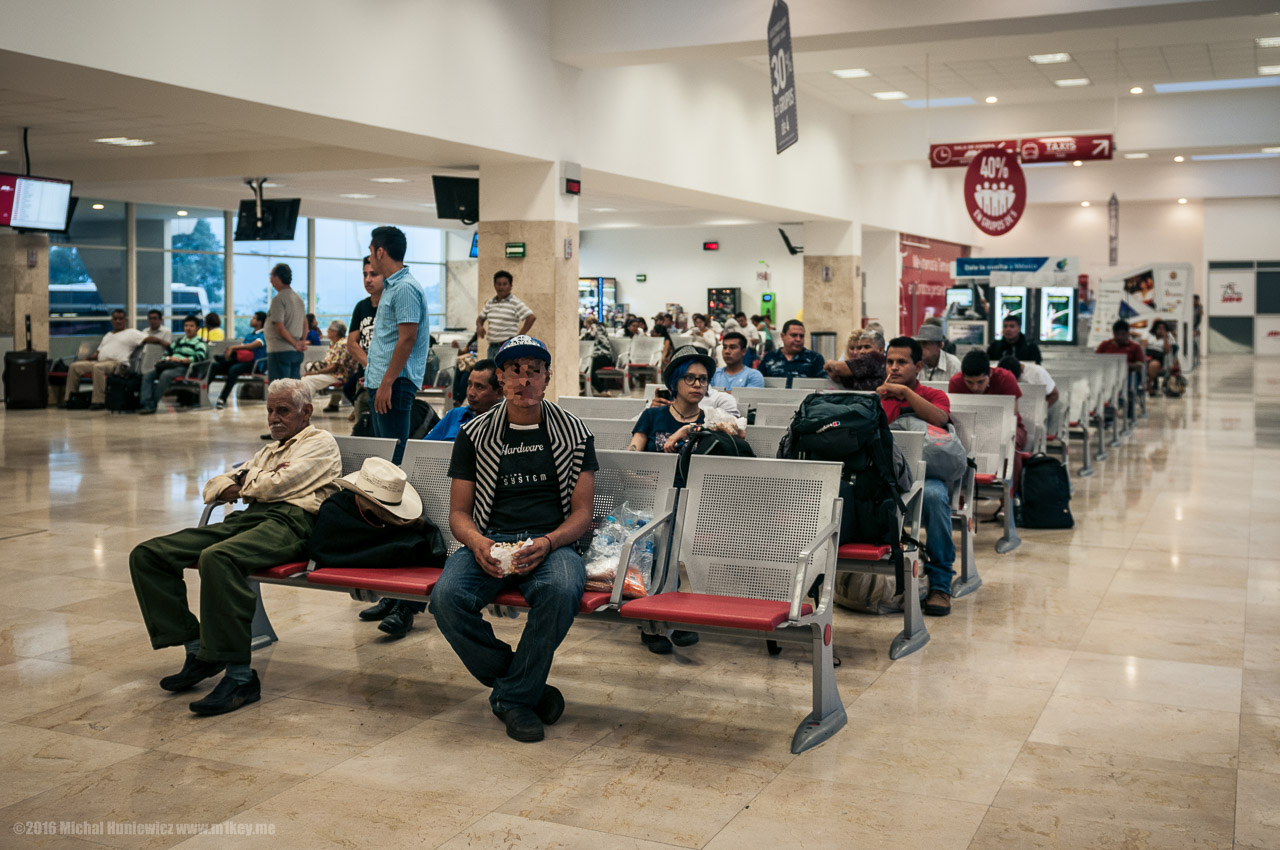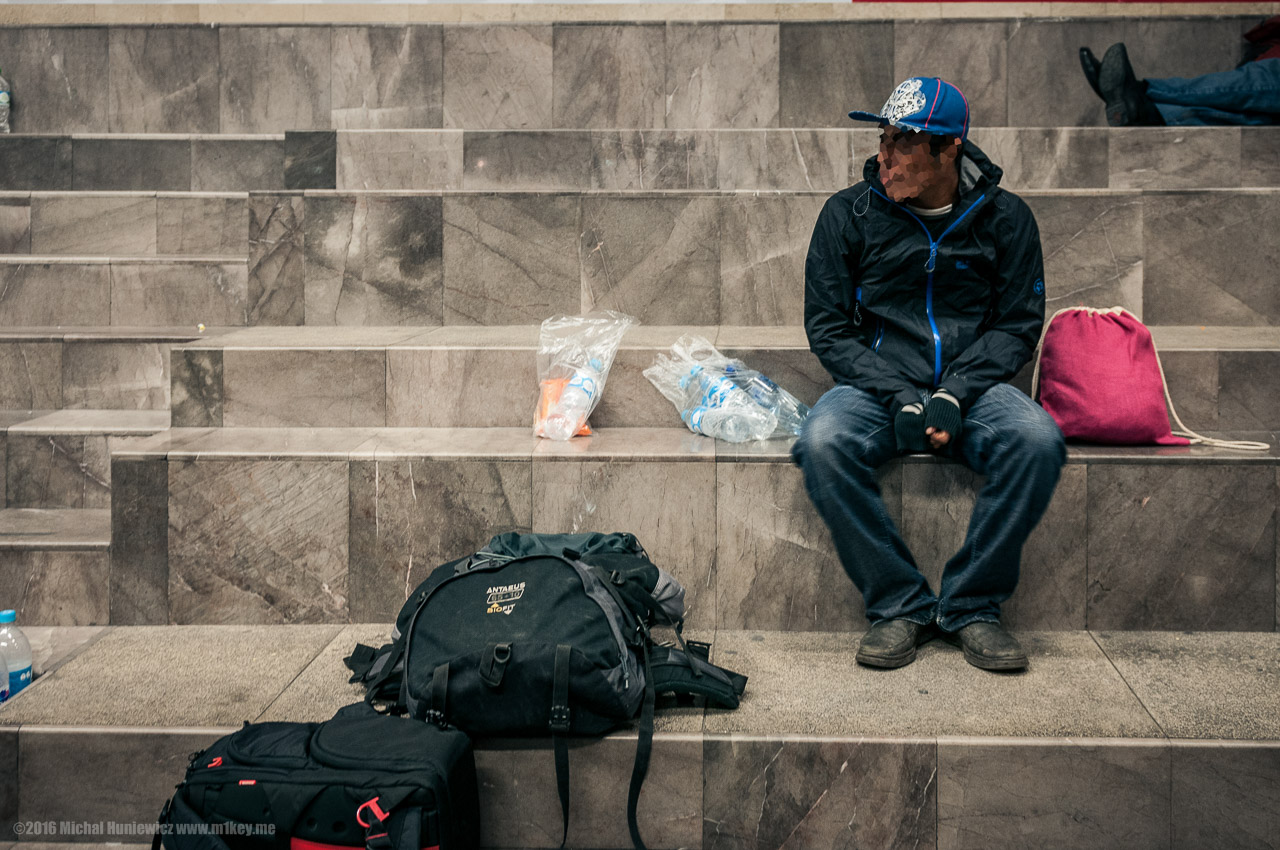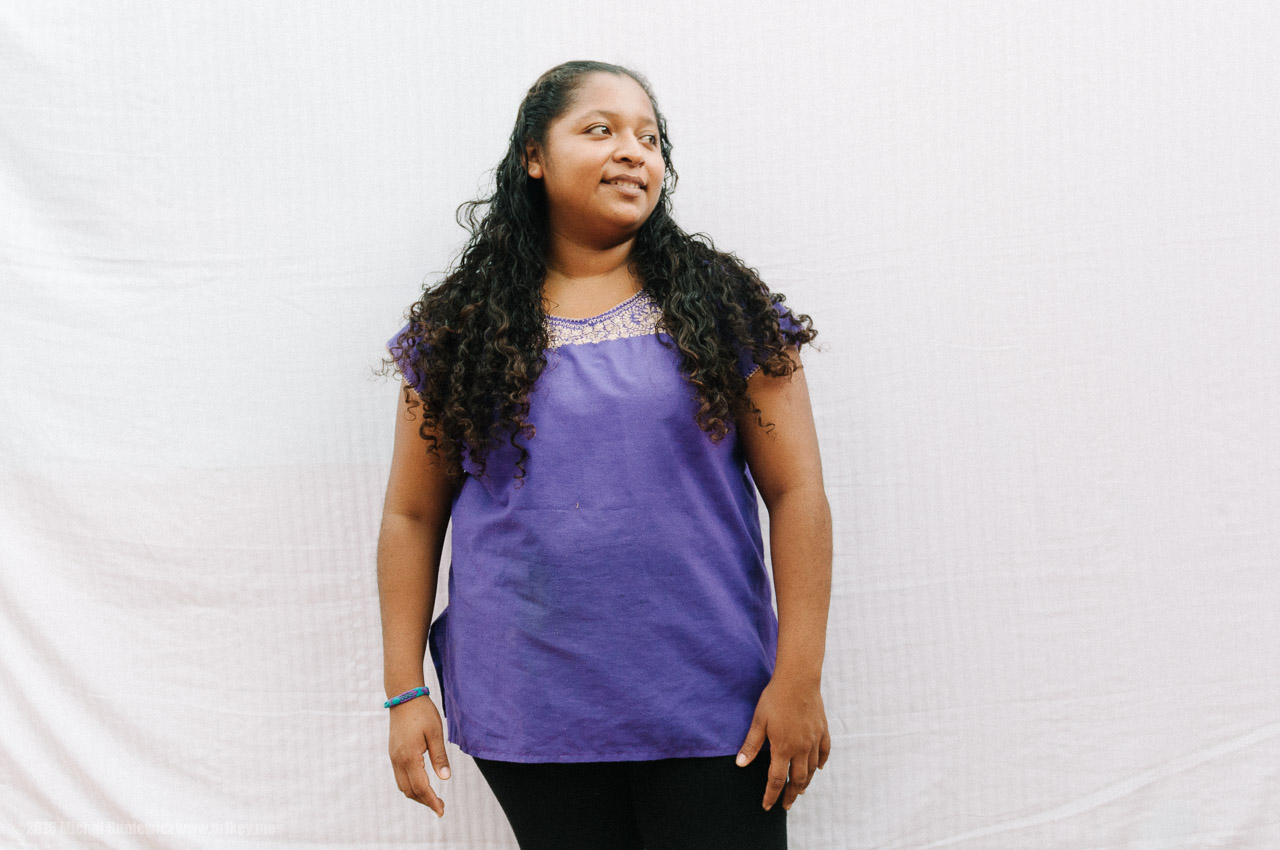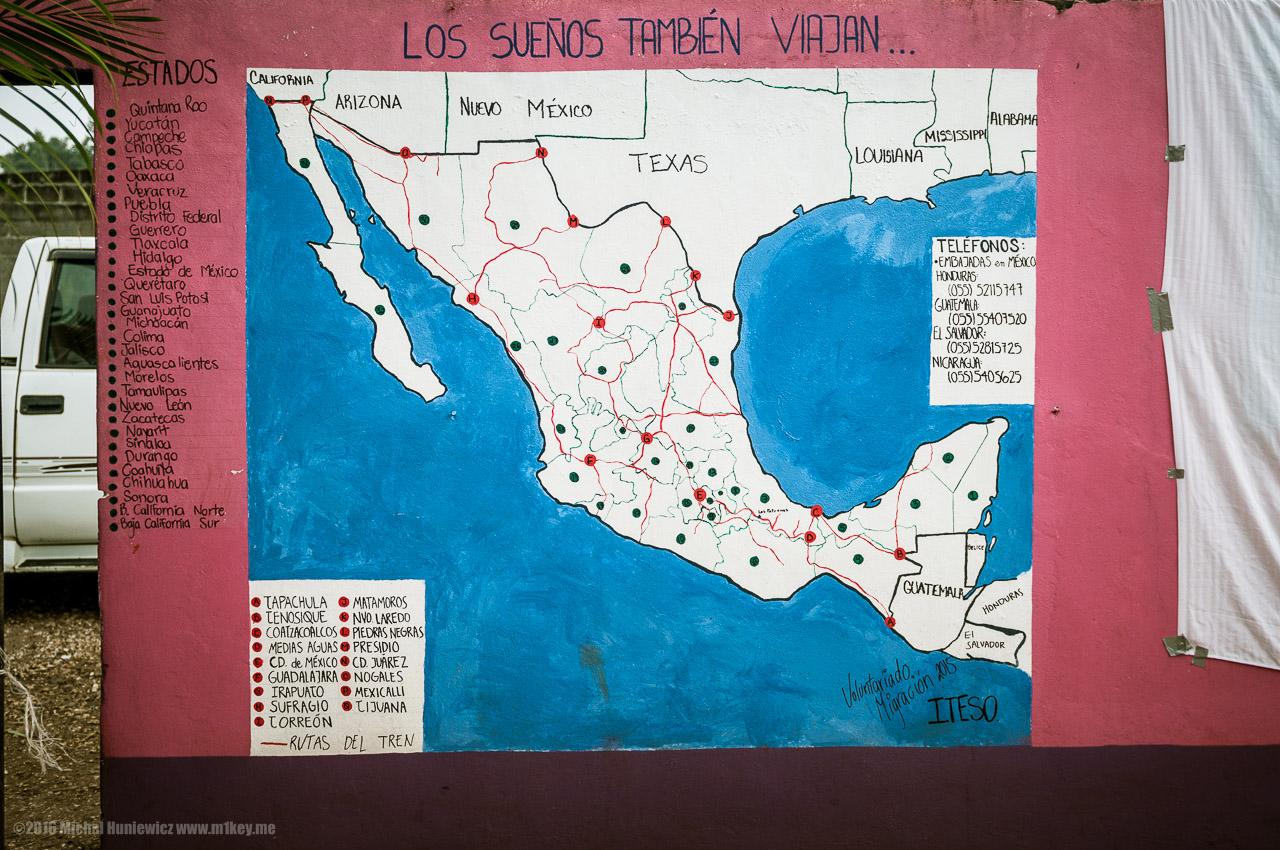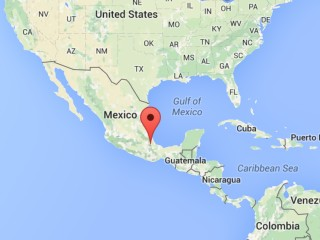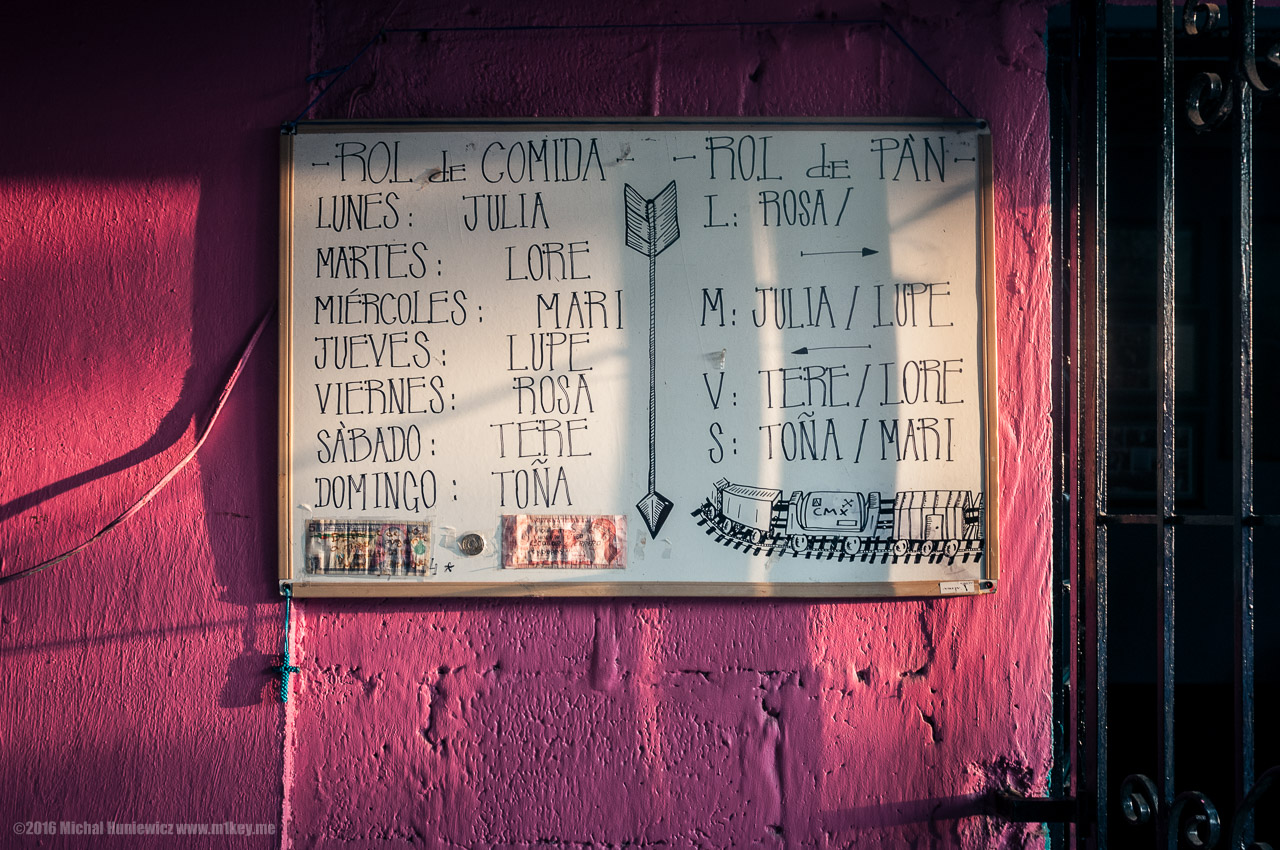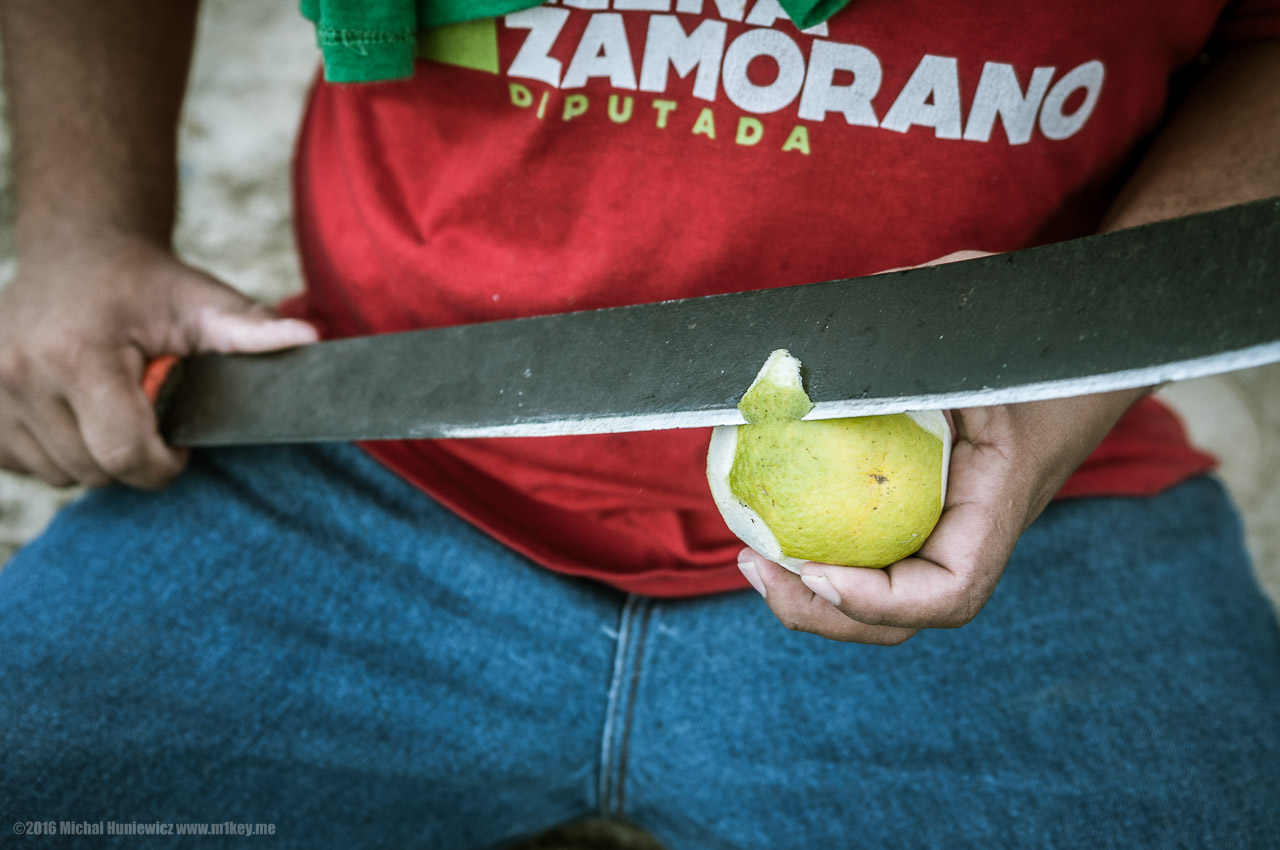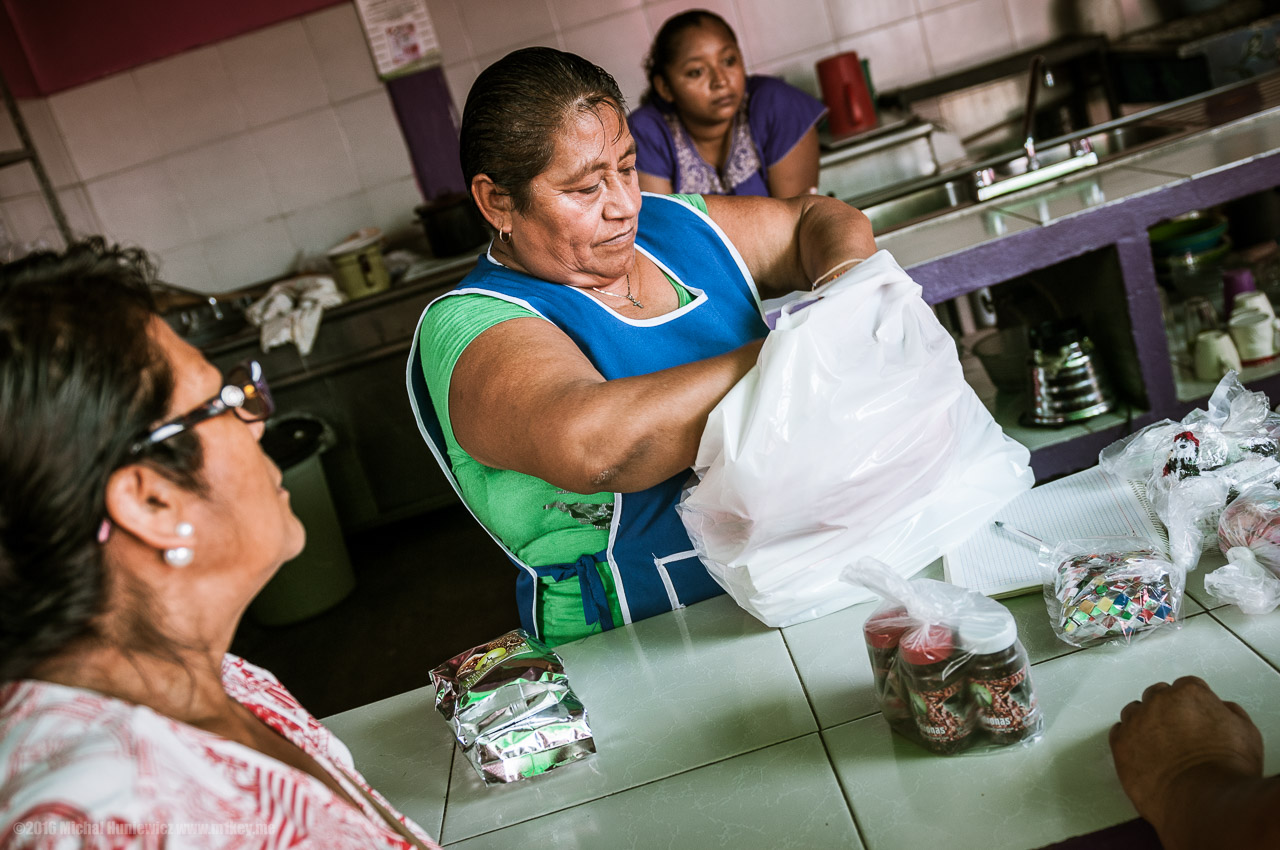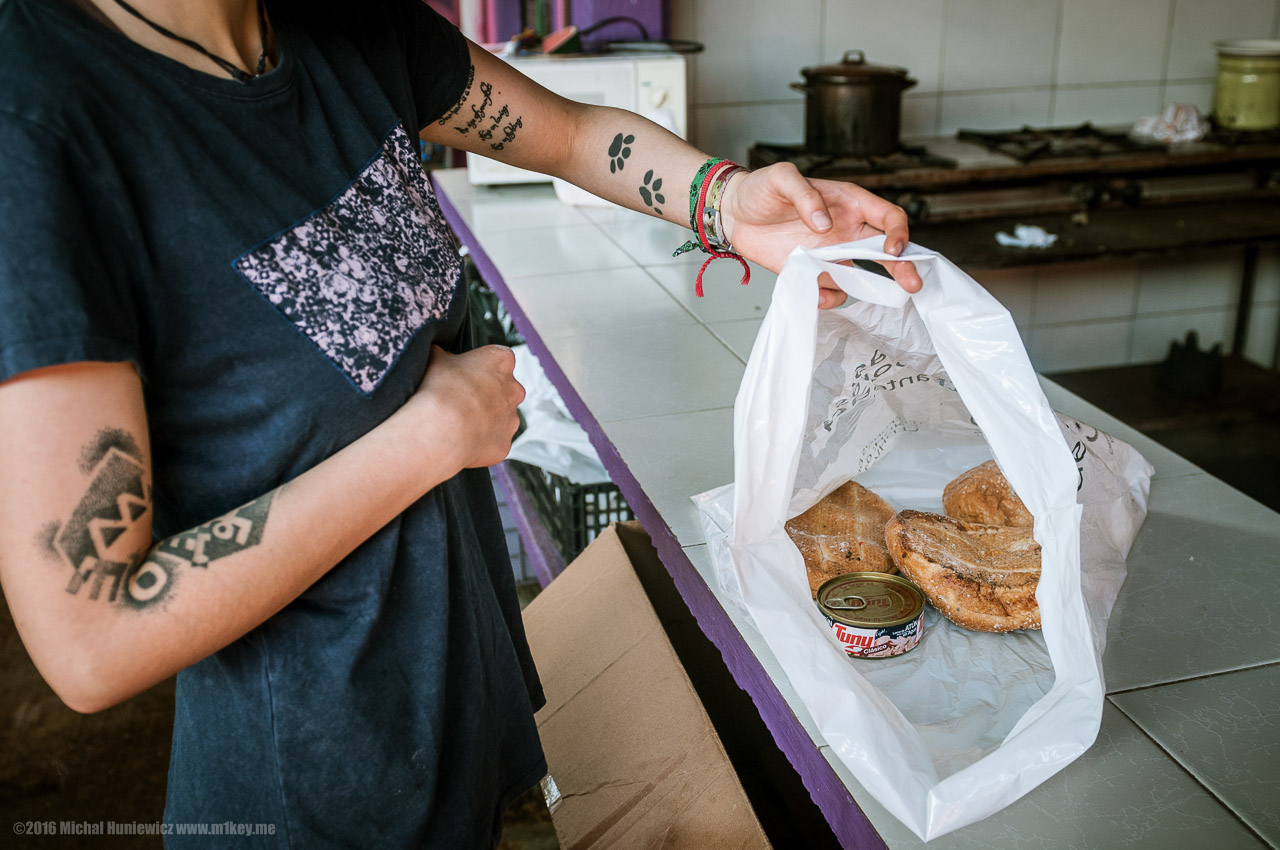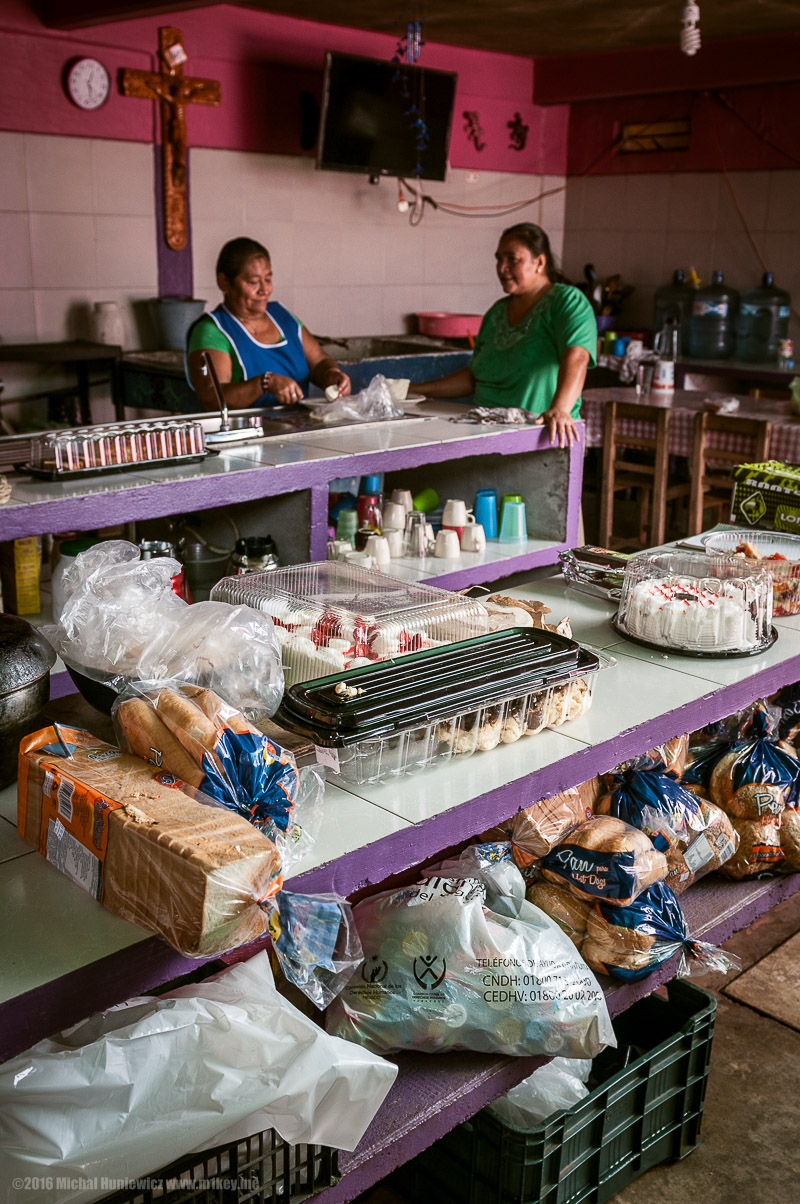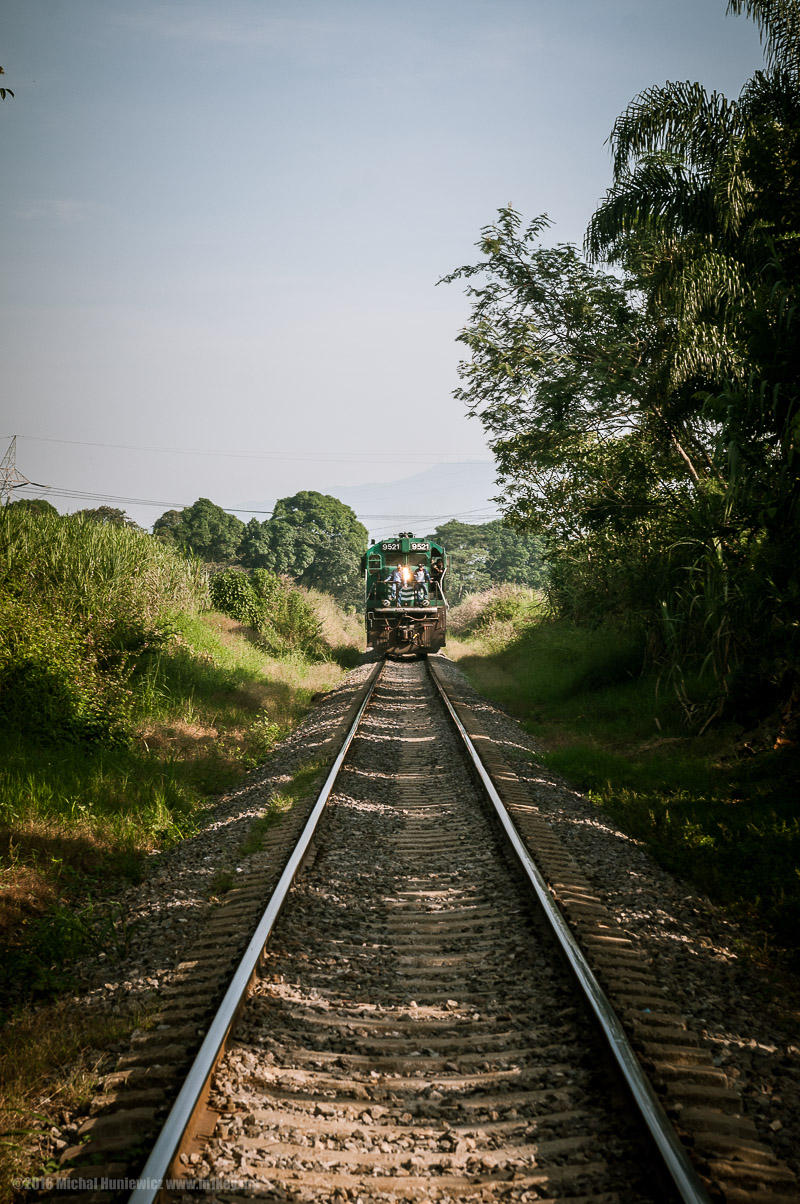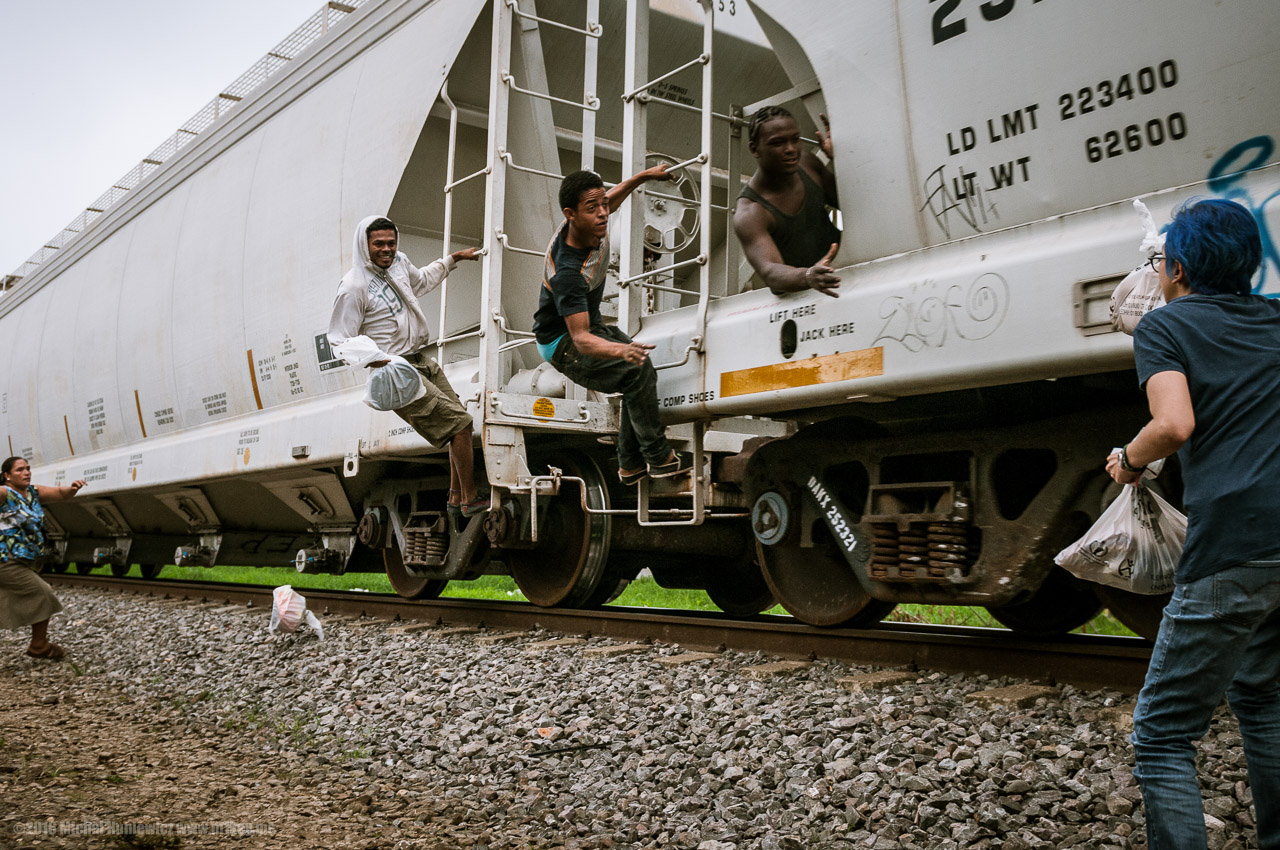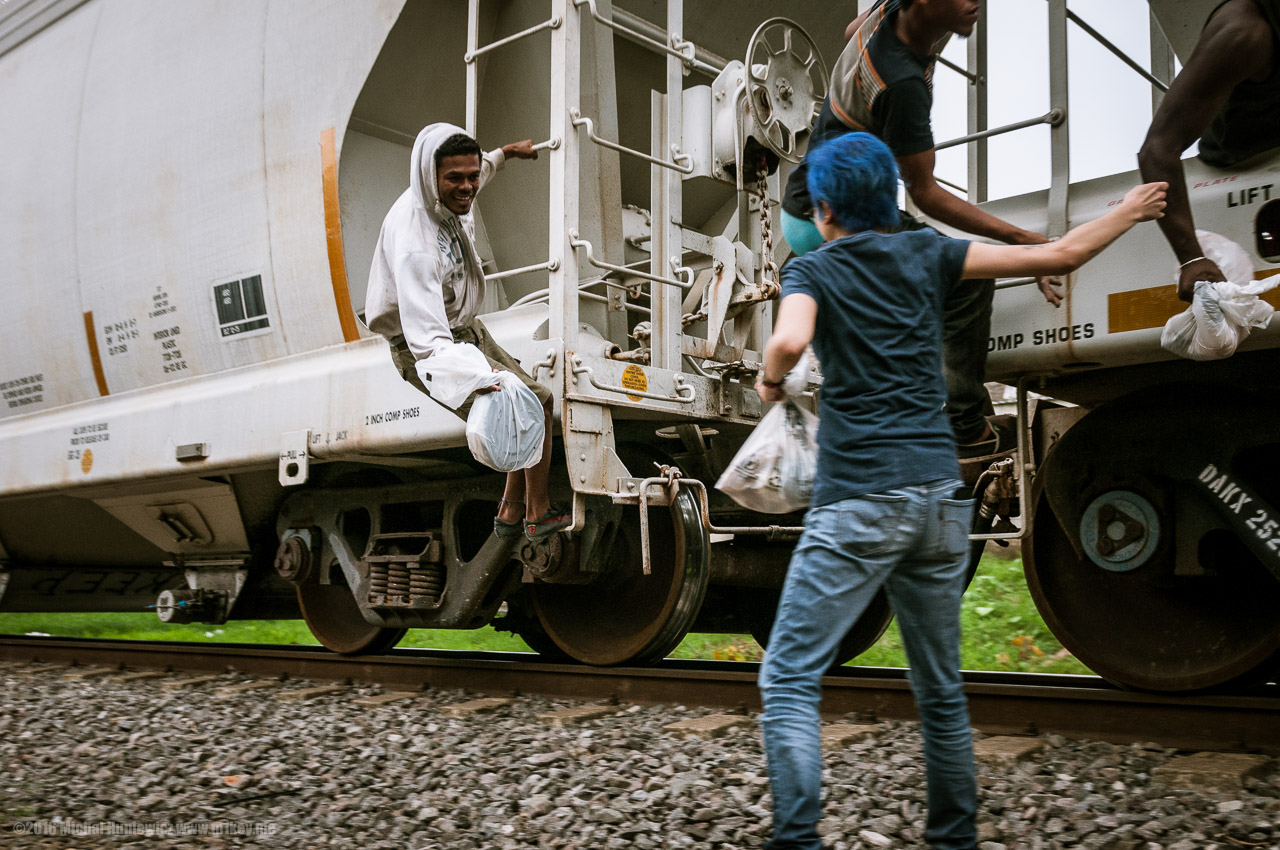Las Patronas Photography - M1key - Michal Huniewicz

The Migrants
This photo story is about Mexican women who try to help them.
ISO 360, 24mm, f/2.8, 1/400s.
Maria Teresa
Migrants have been travelling across Mexico like that for decades, but this story began about 20 years ago, when two of the women from the village of Guadalupe, Norma and Rosa, were walking along the tracks. Over they years, they have been joined by other women.
ISO 200, 24mm, f/2.8, 1/1250s.
Welcome to the Jungle
That day, 20 years ago, a cargo train was passing, and some people riding it called out to the two women: "Mother, mother! Please, we're thirsty! We're hungry!"
ISO 200, 70mm, f/5.0, 1/1000s.
(Cui)dado Con El Tren
Later, it was explained to me that this might have struck a chord with them, because motherhood is so important in Mexico - combining the significance of Mother Mary that's blended with the Aztec goddess, the mother of gods, Coatlicue. The woman eventually became known as Las Patronas, the mothers that take care.
ISO 200, 24mm, f/4.0, 1/500s.
La Patrona
That was when the two women decided they would help the passing migrants. They did not realise how well-organised it would eventually become.
ISO 200, 24mm, f/5.0, 1/40s.
Las Patronas
Until the year 2011, the help was just food and water for the migrants given to them as they were riding the train. But then this facility was built, a walled complex that consists of shelters for the migrants, a kitchen, and an administrative building.
ISO 200, 36mm, f/7.1, 1/80s.
Claudia
I would also like to tell the story from the point of view of the migrants, and there were five of them staying for the night at Las Patronas. Among them, there were two women, a mother (Maria) and a daughter (Claudia, pictured here), who were threatened with rape and subsequently kicked off the train, with the partner of the mother and a man who introduced himself as the boyfriend of the daughter - the two met on the train.
They did not ask me to blur their faces, but I decided to do so anyway and to change their names, to protect their identity, and also because we found out so much about them.
I spent two days there, but the girl only trusted me enough to pose just before I left. The mother never did.
ISO 200, 35mm, f/4.0, 1/4000s.
Through the Gate
The gate separates the world of the legal and the world of the illegal, but the police are not only aware - they also tolerate the migrants, so long as they do not leave the premises.
ISO 200, 24mm, f/4.5, 1/50s.
Duty Rota
The Patronas take turns at managing the complex.
ISO 200, 24mm, f/4.0, 1/80s.
Anabel
My work would not have been possible if it wasn't for Anabel, who kindly agreed to come with me and be my interpreter (my Spanish is very limited) - being an intelligent and perceptive person, she acquired a much greater insight into the minds of the migrants that I could have.
ISO 200, 24mm, f/2.8, 1/250s.
Guadalupe
This is Guadalupe. She's been helping for 17 years. She said that before 2005, the women were completely on their own. In 2005 a film entitled De Nadie was released, a documentary depicting the journey of the migrants, and that was a great advertisement for the women.
"This isn't coming to an end soon, but I do hope one day our work will be no longer needed."
ISO 200, 32mm, f/2.8, 1/2000s.
Utensils
In the kitchen. The food Anabel and I and the migrants were given consisted of tortilla, beans, and eggs.
ISO 200, 24mm, f/2.8, 1/50s.
Locomotive
The gate of the Las Patronas facility is about a minute away from the tracks. There are many trains every day, going in both directions.
ISO 200, 24mm, f/14.0, 1/250s.
Migrants Rooms
These are the rooms for the migrants (ground floor, first floor), with bunked beds. To the left, there are toilets and showers.
ISO 360, 24mm, f/4.0, 1/40s.
Gabriel
Gabriel is the one who introduced himself as Claudia's boyfriend. 22 years old, from El Salvador. After his mother died, he was on his own in El Salvador with his brother, the rest of his family having already gone to the US. He initially told me it was unemployment that made him want to leave, but later added his brother was a gang member, and they decided to leave together when the brother got in trouble; his brother he was caught somewhere in Mexico. He (Gabriel) didn't speak English, had some experience in fishing and welding. He told me Athletic Bilbao were impressed with his football skills, and wanted to try him out in Spain, but he could not afford the flight.
ISO 200, 35mm, f/2.8, 1/2000s.
Beds
This is what migrants' rooms look like. As a migrant, once you make it to this place, you are welcome to stay for up to three nights to recover a bit and regenerate, and to learn about your options. Then, you must leave. If you refuse to leave, the women will call the police.
ISO 400, 24mm, f/2.8, 1/15s.
Migrants Helping
The migrants are expected to help with maintaining cleanness and order.
ISO 200, 24mm, f/5.6, 1/60s.
In the Fields
Why is it just women helping?, I asked.
Initially, they laughed, and said it was "because of the macho thing" among Mexican men, but later admitted men there were usually employed, and the women were not, so they simply had more time to kill. Still, there was one man helping out, and here he is seen removing the weeds together with two of the migrants.
ISO 200, 34mm, f/5.0, 1/160s.
Mujeres Pájaro
Mujeres Pájaro is the organisation that painted the walls. Norma picked the colours - "Mexican pink"
ISO 200, 24mm, f/5.6, 1/320s.
Machete
Emilio peeling off the skin of a fruit.
ISO 200, 32mm, f/2.8, 1/400s.
Rosa
Rosa, one of the two original Patronas. She said the number of migrants was much lower these days, and therefore it was more difficult for them to get to the US. She said everyone expected it to get even more difficult, should Donald Trump win the presidency race.
ISO 200, 38mm, f/2.8, 1/1600s.
Woosh
Anabel and I did a few dry runs of the train photos, so I could get my shutter speed right.
ISO 200, 32mm, f/13.0, 1/125s.
Room
These days, between no people and 15 people show up at this place daily, but one day two years ago, the women arrived to find... 1500 people asking for help.
ISO 220, 24mm, f/2.8, 1/40s.
Donated Food
The food is now donated by private people as well as various organisations, but none are related to the government. The women told me they did not want to be involved in politics.
ISO 200, 60mm, f/2.8, 1/5000s.
Preparing Survival Bags
The women begin to assemble survival bags.
ISO 200, 24mm, f/2.8, 1/100s.
Preparations
They are surprisingly well-organised. Because there are now multiple facilities like this one, the women stay in touch, and inform one another about incoming trains with migrants. Las Patronas is the first group to have been created.
ISO 200, 70mm, f/3.5, 1/60s.
Emilio
Emilio was the only skilled worker among the five people. After many hours of chatting in Spanish (with the help of Anabel), he suddenly spoke to me in English. Initially it was him, his partner Maria, and her daughter Claudia travelling together. Later, Gabriel joined them and became the boyfriend of Claudia. But Emilio said he didn't trust Gabriel.
And I suppose he was right, because Gabriel later told us he was prepared to leave both Maria and Claudia behind in his journey to the US, as they were crossing the desert.
"In Honduras, gang members have no honour".
ISO 200, 38mm, f/2.8, 1/1600s.
Survival Bag
Anabel showing the contents of a survival bag.
ISO 200, 24mm, f/3.5, 1/100s.
Text Materials
Some bags come also with written materials, including a booklet in Hebrew, that mentions in Spanish "you will not understand what it says, but it will bring you good luck".
ISO 200, 24mm, f/4.0, 1/60s.
Food
The quantity of food delivered during the day was large.
ISO 200, 24mm, f/4.0, 1/80s.
Bread
The women estimated that roughly half of Mexicans approved of what they were doing.
ISO 200, 24mm, f/3.2, 1/320s.
Awaiting
Although all the women I met there were Mexican, they mentioned French, Canadian, and Mexican volunteers helping out in other places like this one.
ISO 200, 58mm, f/2.8, 1/100s.
From Tijuana
Everyone mentioned it was much harder for Latinoamericans in terms of getting in the US than, say, people from Africa or the Middle East. They said political correctness that protected those people did not apply to Latin Americans, and they were really tired of being picked on by American media and politicians.
ISO 200, 44mm, f/2.8, 1/2000s.
The Train is Coming
And then Anabel heard the train coming.
ISO 200, 70mm, f/8.0, 1/160s.
Bag Dropped
Everybody ran with bags of food, one person with a wheelbarrow.
In the photo, the man on the right reacts after having dropped the bag.
ISO 400, 24mm, f/2.8, 1/400s.
Next Chance
Anabel was next though, so he had another chance.
ISO 400, 24mm, f/2.8, 1/400s.
Success
And he got it.
ISO 400, 24mm, f/2.8, 1/400s.
More Migrants
This is more dangerous than it looks. I was surprised by how fast the train was. Migrants occasionally fall, and it does happen that they get sucked underneath the train.
ISO 400, 24mm, f/2.8, 1/320s.
Seems Like No More Migrants
In that case, they often have their limbs severed in front of everyone. Last time it happened, a lot of women left, as they felt guilty, and could not get the screaming out of their heads.
ISO 200, 34mm, f/3.2, 1/250s.
No More Migrants
One such person lost his leg - he was a 17 year old boy from Guatemala. He received medical attention in Mexico, and then had to return to Guatemala. Because of his appearance in a documentary, he was able to come back to Mexico, and it seemed he'd be able to escape his life in Guatemala. He was, however, deporeted, having failed to find a job in Mexico.
ISO 360, 48mm, f/2.8, 1/320s.
Back to the Shelter
But this is not the only threat those people are facing. They are attacked by Mara Salvatrucha (MS-13), a gang that brutally forces them to pay up or kicks them off the train.
The migrants complain also about the police, who sometimes don't arrest them, but harass them as well, knowing the illegal migrants can't expect receiving legal help without being deported.
ISO 200, 70mm, f/3.2, 1/125s.
La Chaparra
Julia, also known as La Chaparra ("the Shortie"). She's been helping for 16 years. She said the migrants don't carry any phone numbers with them, as it increases the risk of being kidnapped for ransom by a gang.
ISO 200, 24mm, f/2.8, 1/3200s.
Ofrenda
I visited during the Day of the Dead - here, an ofrenda is being prepared, or an offering, in order to create a ritual altar.
ISO 200, 24mm, f/2.8, 1/1000s.
At the Gate
Jorge was on the train the day I arrived, but fell as he was reaching for a survival bag, and hurt his back somewhat. The little money he had was left on the train. He didn't know anyone in Mexico or in the US.
ISO 200, 70mm, f/3.2, 1/4000s.
Jorge
He told me it was OK for him to stay in Mexico, but he probably would have to marry a Mexican to make it possible. His only option was to try to walk at night to a place where the train slows down so he could get back on it.
ISO 200, 32mm, f/2.8, 1/2000s.
Time to Leave
As it was time for Anabel and me to leave, I made a decision to take Jorge with us.
ISO 200, 24mm, f/5.6, 1/60s.
Getting Jorge Out
Taxi first. We had to get him past security check points with heavily armed police, so I was flashing my white tourist face, while Jorge tried to look inconspicuous in the back.
ISO 1000, 5mm, f/2.0, 1/60s. Phone photo.
Jorge in Córdoba
Anabel and I got him some food and water, plus a magazine, so that he wouldn't die out of boredom on the coach. We were sat separately in case someone did catch him.
ISO 200, 24mm, f/2.8, 1/50s.
Terminal de Autobuses de Pasajeros de Oriente
But we safely made it to Mexico City.
ISO 400, 24mm, f/2.8, 1/25s.
Waiting for the Taxi
I gave him my jacket to wear so he wouldn't look so much like an illegal migrant. I learnt something about Mexico that night - Anabel called a taxi that would take him safely to a shelter where he could stay for a couple of months, and learn how to live and get by in Mexico. However, that was no ordinary taxi, but some sort of extra secure taxi with various safety measures (like GPS) to make sure he were delivered to his destination. Apparently, women use that taxi service at night to minimise the risk of being assaulted by the driver.
The shelter workers were angry with us because we delivered Jorge around 3 AM.
ISO 400, 24mm, f/2.8, 1/25s.
Mariela
Mariela was one of the youngest patronas. They call her "mother", nevertheless. She said she went to the US, but did not like it, and would never want to live there, she felt like an outcast, not being able to speak the language. She admitted that roughly 90% of the migrants could not speak English, but the US was "built by immigrants, and the US should give everyone a chance". She added that "if they behave badly, they should be deported from the US". In her opinion, Mexico has the potential to be able to easily cater for those migrants as well, if not better than the US, but it was poorly administered.
She also witnessed the boy being mutilated by the train, but it didn't discourage her. She said it made her want to work more, because he was so strong after the accident, and also because her body was complete unlike his.
ISO 200, 24mm, f/2.8, 1/640s.
Map
Not a single migrant I talked to even considered going south, to Chile, Brazil, or any other country in South America.
ISO 200, 24mm, f/2.8, 1/1250s.
Thanks for Watching
We helped Jorge, but the remaining four migrants were yet to make an attempt to get further north, and walk across the desert. At night, we overheard them telling jokes, how after all that effort they'd be shot by American border police.
ISO 50, 5mm, f/2.0, 1/250s. Phone photo.

